THE 2021 ACF NATIONAL CONVENTION
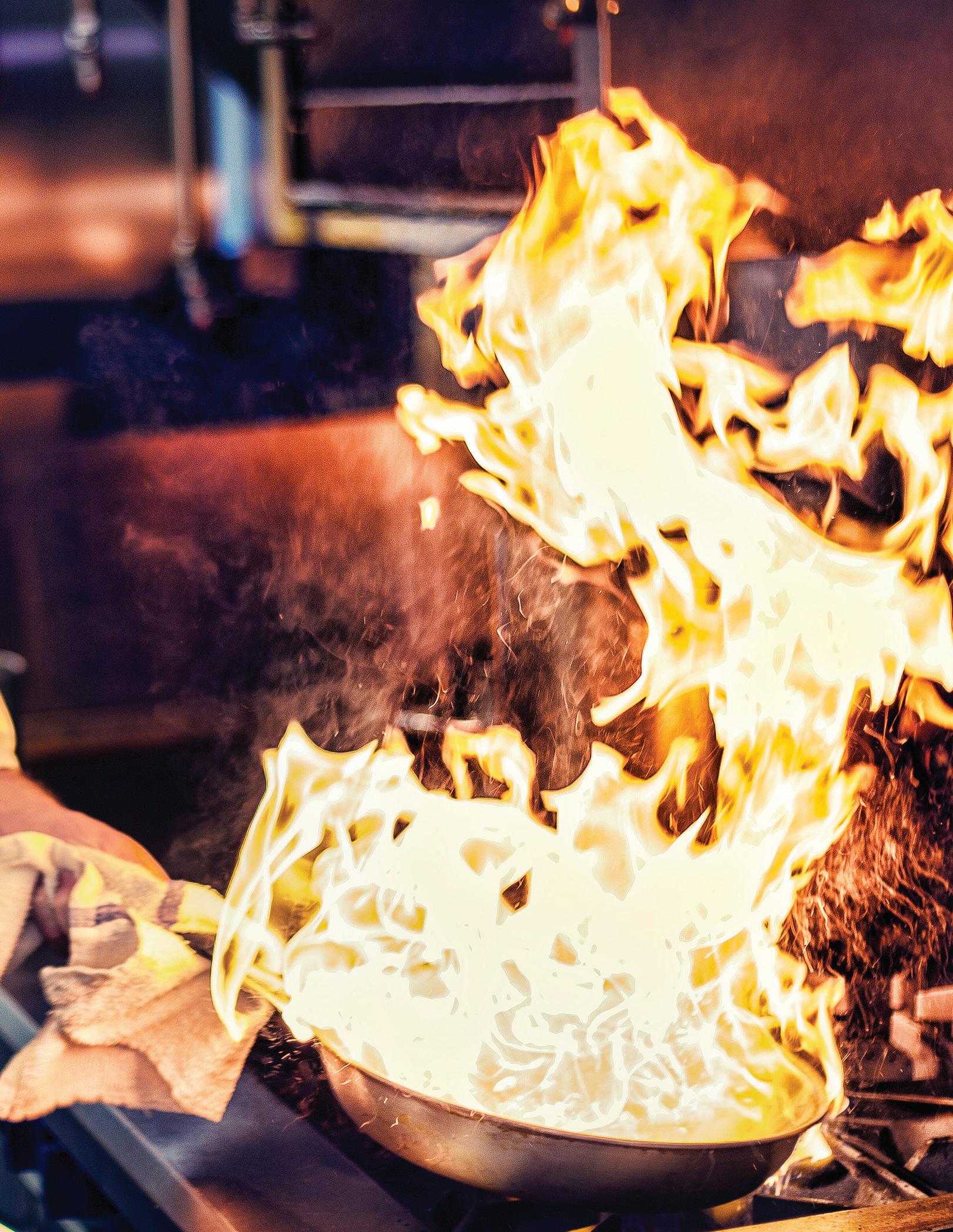
JULY/AUGUST 2021


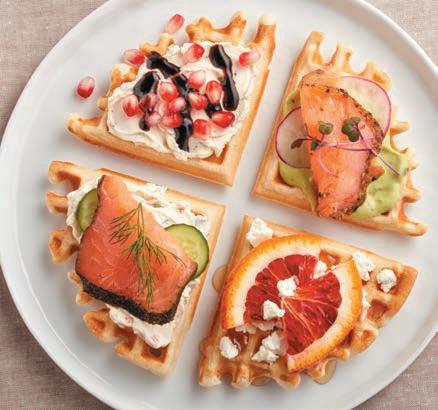

Flexible Adaptability to access a range of mixes that enable operators to shift and respond as demand changes… from Breakfast to Dessert. [əˌdaptəˈbilədē] NOUN Our Buttermilk Pancake & Waffle Mix is just one of many complete mix options ready to support your ever-changing menu — with 100% yield & zero waste. Contact us for your own sample to try. jiffyfoodservice.com
FEATURE STORIES
30
The 2021 ACF National Convention
We caught up with a handful of speakers presenting at the convention. Plus, a sneak peak of some of the planned sessions and a walk through the history of the American Academy of Chefs ahead of the 49th Annual Induction Dinner.
DEPARTMENTS
12 Management
18
22
24
28
Three women chefs talk about managing their kitchens and how to lead teams to success.
Main Course
These food truck chefs/owners prove that mobile food can be just as sophisticated as plated.
On the Side
Advice on equipping a food truck or other mobile kitchen for top form and function.
Pastry
Pastry chefs are putting their own creative spins on baked Alaska and other summertime favorites.
Classical vs. Modern
Chef Jeffrey Schlissel prepares a classic salad Niçoise, as well as a modern plant-based version that swaps tuna for “smoked” watermelon slices.
42 Health
Though some may say corn is nothing more than a starchy carb, one ACF chef notes its nutritional value and importance in both seasonal and heritage dishes.
44
Segment Spotlight
Segment Spotlight: Though states are reopening, these chefs say culinary education — and the remote possibilities — has changed forever. Find out how.
50 At The Bar
The word “mocktails” may be going out of fashion, but these elaborate alcohol-free drinks are still as on-trend as ever. Here’s why.
WEARECHEFS .COM 3
IN EACH ISSUE 4 President’s Message 6 On the Line 8 News Bites 16 Chapter Close-Up 38 ACF Chef Profile 40 Chef-to-Chef 54 The Quiz
Editor-in-Chief
Amelia Levin
Creative Services Manager
David Ristau
Graphic Designer
Armando Mitra
Advertising and Event Sales
Eric Gershowitz
Jeff Rhodes
Director of Marketing and Communications


Alan Sterling
American Culinary Federation, Inc.
180 Center Place Way • St. Augustine, FL 32095 (800) 624-9458 (904) 824-4468 Fax: (904) 940-0741 ncr@acfchefs.net ACFSales@mci-group.com www.acfchefs.org
Board of Directors
President
Thomas Macrina, CEC®, CCA®, AAC®
National Secretary
Mark Wright, CEC, AAC
National Treasurer
James Taylor, CEC, AAC, MBA
American Academy of Chefs Chair
Americo “Rico” DiFronzo, CEC, CCA, AAC
Vice President Central Region
Steven Jilleba, CMC®, CCE®, AAC
Vice President Northeast Region
Barry R. Young, CEC, CCE, AAC
Vice President Southeast Region
Kimberly Brock Brown, CEPC®, CCA, AAC
Vice President Western Region
Robert W. Phillips, CEC, CCA, AAC
Executive Director Heidi Cramb
The National Culinary Review® (ISSN 0747-7716), July/August
2021, Volume 45, Number 4, is owned by the American Culinary Federation, Inc. (ACF) and is produced 6 times a year by ACF, located at 180 Center Place Way, St. Augustine, FL 32095. A digital subscription to the National Culinary Review® is included with ACF membership dues; print subscriptions are available to ACF members for $25 per year, domestic; nonmember subscriptions are $40. Material from the National Culinary Review®, in whole or in part, may not be reproduced without written permission. All views and opinions expressed in the National Culinary Review® are those of the author and do not necessarily reflect the views and opinions of the officers or members of ACF. Changes of mailing address should be sent to ACF’s national office: 180 Center Place Way, St. Augustine, FL 32095; (800) 624-9458; Fax (904) 940-0741.
The National Culinary Review® is mailed and periodical postage is paid at St. Augustine, Fla., and additional post offices.
POSTMASTER: Send address changes to the National Culinary Review®, 180 Center Place Way, St. Augustine, FL 32095.

It’s a bittersweet moment for me.
This is my last letter as president, but my work with and commitment to the ACF and our membership will not end. I remain committed to helping progress the organization as I transition to immediate past president of the board.
Speaking of which — I would like to thank the current board, all of our members, our sponsors, industry and association partners and ACF staff
for all of your support during this very challenging past year. In a time of crisis, we chefs did what we do best: come together to help each other and our communities. But the effort has not and will never stop.
As we usher in a new era and a return to normalcy that grows day by day, I would like to extend a warm congratulations to President-Elect Kimberly Brock Brown, CEPC, CCA, AAC, and the newly elected board members who will lead us into the future. You can read more about these remarkable chefs on page 8.
I would also like to congratulate the newly chosen members of ACF Culinary Team USA 2024. It is a special honor to be selected as part of this stellar team, which will represent our organization and country on the international stage. I look forward to working with everyone as chair of the American Culinary Federation Education Foundation (ACFEF). To read more about the team, turn to page 10.
Another big congratulations to the winners of the ACF Regional Awards — all very well-deserved. For the full list of award winners, turn to page 11, and you can also watch a video recapping the virtual ceremony on ACF’s YouTube channel. National winners will be announced during the 2021 ACF National Convention next month.
That’s a perfect segue: You all know I have been counting down the days until the convention, and now it’s almost here! It’s been way too long since we have seen each other in person, and this convention will truly be a homecoming for us in that regard. I’m also excited about the lineup of amazing speakers and presenters that ACF has put together. It will be fun to be a presenter myself: I will be joined by Chef Greg Matchett, CEC, and Chef Jim Taylor, CEC, AAC, for a presentation on ways to create on-trend menu items that highlight plant proteins and sustainability. Competitions have always been a central part of the convention, and this year is no different. We have amassed an outstanding group of more than 60 professional and student chef competitors. We will also have 10 competition kitchens going on this year, which is the most we have had in ACF history. Competitors will compete for the Chef of the Year, Student Chef of the Year, Pastry Chef of the Year and Student Team of the Year awards, which will be announced during the convention. A huge thank you to Southbend for providing all of the equipment.
It’s been a wild ride, my fellow ACF chefs. I tip my toque to all of you for all you have done over the years, and particularly this past year. I’ll see you all very soon.
Warmly,
Thomas “Tom” Macrina, CEC, CCA, AAC National President American Culinary Federation
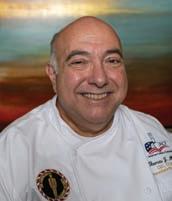
4 NCR | JULY/AUGUST 2021 | President’s Message | Un Mensaje Del Presidente |
Contact me at tmacrina@acfchefs.net or follow me on Twitter @cheftommacrina and Instagram @cheftommacrina
En este momento estoy lleno de sentimientos encontrados.
Esta es mi última carta como presidente, pero mi trabajo y compromiso con la ACF y nuestra membresía no se terminarán. Sigo comprometido a contribuir al avance de la organización a medida que hago la transición para pasar a ser expresidente inmediato de la junta.

Ya que estoy en tema, me gustaría agradecer a la junta actual, a todos nuestros miembros, patrocinadores, socios de la industria y la asociación, así como también al personal de la ACF por todo su apoyo durante este año tan desafiante que pasó. En tiempos de crisis, los chefs hicimos lo que mejor sabemos hacer: unirnos para ayudarnos unos a otros y colaborar con nuestras comunidades. Pero el esfuerzo no se ha detenido y nunca se detendrá.
A medida que iniciamos una nueva era y nos embarcamos en el retorno a la normalidad que crece día a día, me gustaría extender una cálida felicitación a la presidenta electa Kimberly Brock Brown, CEPC, CCA, AAC y los miembros de la junta recién elegidos que nos dirigirán en miras al futuro. Para conocer más sobre estos destacados chefs, pase a la página 8.
También me gustaría felicitar a los miembros recién elegidos del equipo ACF Culinary Team USA 2024. Es un honor especial ser seleccionado como parte de este equipo estelar, que representará a nuestra organización y país en el escenario internacional. Espero trabajar con todos como presidente de la Fundación Educativa de la American Culinary Federation (ACFEF). Para leer más sobre el equipo, pase a la página 10.
También felicito enormemente a los ganadores de los Premios Regionales de la ACF, todos muy bien merecidos. Para ver la lista completa de los ganadores de los premios, pase a la página 11; también podrá ver un video que resume la ceremonia virtual en el canal de YouTube de la ACF. Los ganadores nacionales se anunciarán durante la Convención Nacional de la ACF 2021 el próximo mes.
Eso me da el pie perfecto para lo que sigue: todos saben que he estado contando los días hasta la convención, ¡y ya casi está aquí! Ha pasado demasiado tiempo desde la última vez que nos vimos en persona, y esta convención realmente será un regreso a casa para nosotros en ese sentido. También estoy entusiasmado con la lista de oradores y presentadores increíbles que ha reunido la ACF. Será divertido ser presentador: me acompañarán el chef Greg Matchett, CEC, y el chef Jim Taylor, CEC, AAC, para dar una presentación sobre formas de crear elementos de menú de tendencia que destaquen las proteínas vegetales y la sostenibilidad.
Las competencias siempre han sido una parte central de la convención, y este año no será la excepción. Hemos reunido a un grupo destacado de más de 60 chefs competidores profesionales y estudiantes. También contaremos con 10 cocinas de competición este año, la máxima cantidad que hemos tenido en la historia de la ACF. Los competidores participarán por los premios al Chef del año, Chef estudiante del año, Chef pastelero del año y Equipo estudiantil del año, que se anunciarán durante la convención. Un gran agradecimiento a Southbend por aportar todos los equipos.
Hemos recorrido un camino emocionante, mis compañeros chefs de ACF. Me saco el sombrero ante todos ustedes por lo que han hecho a lo largo de los años, y en particular este último. Nos vemos muy pronto.
Con gran cariño,
Thomas “Tom” Macrina, CEC, CCA, AAC Presidente Nacional American Culinary Federation
WEARECHEFS .COM 5
What’s Cooking on WeAreChefs.com
Visit WeAreChefs.com, the official content hub for the American Culinary Federation, to read online exclusive articles, including industry trends, interviews, COVID-19 coverage, recipes and more.
ACF ChefsForum Webinar Series
The ACF ChefsForum Webinar Series has been a smashing success, with high attendance each session. Enjoy everything from cooking with beer to an educational session on modern barbecue techniques, lamb butchery and advanced baking and pastry — with more planned for the coming months. Missed a webinar? All recorded sessions are available online.
ACF News + More
You’ll find recent announcements from ACF, including election results, awards and more on WeAreChefs.com. Plus, catch up on some articles posted about plant-based nutrition as well as another Dissecting the Dish article featuring one ACF chef’s favorite berry salad, perfect for the summertime.
Chef Profiles
NCR’s ACF Chef Profile column regularly features member success stories, but there is so much more to share outside of the magazine’s bimonthly issues. Visit WeAreChefs.com to read more about your fellow members and their work and careers.
The Culinary Insider, the ACF’s bi-weekly newsletter, offers timely information about events, certification, member discounts, the newest blog posts, competitions, contests and much more. Sign up at acfchefs.org/tci.
Follow the ACF on your favorite social media platforms:




@acfchefs
@acfchefs @acf_chefs
@acfchefs American Culinary Federation
Twitter question of the month:
What part of the ACF National Convention ignites your passion you the most?

Tweet us your answer using the hashtag #ACFasks and we’ll retweet our favorites.
ACF’s Online Learning Center
Check out ACF’s Online Learning Center. There you’ll find NCR quizzes, videos of educational sessions from ACF events, practice exams for certification and more. Visit learn.acfchefs.org to get started.
6 NCR | JULY/AUGUST 2021 | On the Line |
WE’RE SETTING THE TABLE FOR AN INDUSTRY COMEBACK.
Helping You Make Sure Clean and Safe Are Always on the Menu
When it comes to meeting consumer expectations for cleanliness, the stakes have never been higher. You need to safeguard guests and staff, and your reputation. Ecolab is powered by the industry’s largest team of science and engineering leaders with food safety and public health expertise. Based in science, our EPA-registered chemistry and patented solutions are tough on pathogens and pests — and easy on your operations.
85% of consumers say visible evidence of cleanliness is important to feeling safe.1
Outdoor dining and carryout services open the door to new and changing pest risks in your facility. 1https://www2.deloitte.com/us/en/pages/about-deloitte/articles/press-releases/
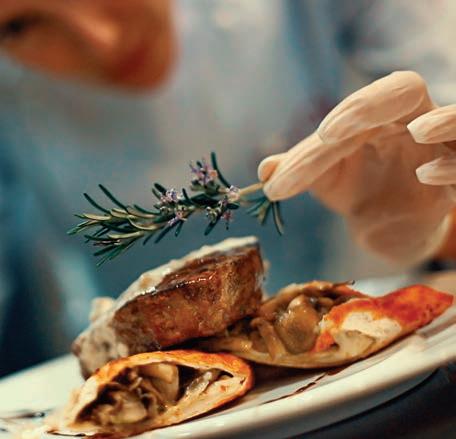

Your partner for cleaner, safer dining. ECOLAB.COM/ABOUT/INDUSTRIES-WE-SERVE/ FOODSERVICE/RESTAURANTS

deloitte-the-restaurant-of-the-future-arrives-ahead-of-schedule.html ©2021 Ecolab USA Inc. All rights reserved.
NEWS BITES
Meet Your New President and Board Members
ACF announced in May the results of this year’s election. New board members will formally take office during the 2021 ACF National Convention in Orlando, Florida, and serve a twoyear term.
National President Kimberly Brock Brown, CEPC, CCA, AAC
Chef Brock Brown is currently serving her second two-year term as vice president of ACF’s southeastern region. It’s the second largest ACF region and includes eight Southeastern states, the U.S. Virgin Islands, Puerto Rico, the Bahamas and Jamaica. In 2017, Chef Brock Brown became the first woman and woman chef of color elected to the ACF board. A native of the Chicago area, Chef Brock Brown is the founder of Culinary Concepts, LLC, offering catering, corporate chef, personal chef and consulting services. She joined ACF in 1981 while completing an apprenticeship program at El Centro College in Dallas, where she was inducted into the school’s chefs hall of fame in 2015. During her nearly 30-year career, she has worked as an executive pastry chef in health care and corporate settings and served as an adjunct professor at Trident Technical College and Johnson & Wales University, both in Charleston. The awardwinning chef has participated in a variety of ACF-sanctioned competitions and was instrumental in the development of ACF’s Certified Culinary Administrator certification.
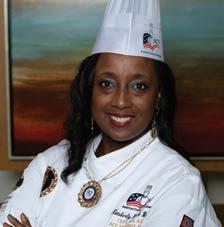
National Secretary Jeff Bacon, CEC, CCA, AAC
Chef Bacon is the executive director of Providence Restaurant and Catering, an extension of the Second Harvest Food Bank of Northwest North Carolina. A 38-year veteran of the culinary industry, Chef Bacon also oversees the Providence Culinary Training and Providence Community Meals programs to train students and serve meals to children, seniors and
other individuals who struggle to provide nourishment for themselves and their families.
Chef Bacon is a two-time recipient of the ACF President’s Medallion and is only one of a handful of people since 1929 to receive the honor more than once.
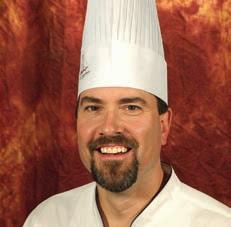
National Treasurer David IveySoto, CEC, CCA
Chef Ivey-Soto is the founder of Chef David Industries, a foodservice consultancy. He is also an adjunct instructor at Brightwater: A Center for the Study of Food, located in Bentonville, Arkansas, and Howard Community College and Prince George’s Community College, both in Maryland. He holds an MBA from the College of William & Mary and earned his associate’s degree from the Culinary Institute of America in Hyde Park, New York. Before starting his companies, Chef IveySoto was the training development manager at UniPro Foodservice, Inc. He has competed in many culinary competitions, receiving a range of medals and awards.
Chef Ivey-Soto lives in Alexandria, Virginia, with his wife, Lisa Ivey.
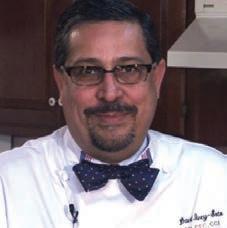
Vice President, Central Region Rajeev Patgaonkar, CEC, AAC
Chef Patgaonkar was born and raised in a city near Kolhapur, India. He studied at what is now the Institute of Hotel Management, Catering Technology and Applied Nutrition in Mumbai, India. Prior to joining the Kellogg Hotel & Conference Center at Michigan State University as executive sous chef, a position he has held for the past 26 years, Chef Patgaonkar worked for Hilton Hotel Oman in Saudi Arabia, the Ambassador’s Sky Chef and the five-star Oberoi Hotel in Mumbai and Carnival Cruise Lines, among other companies. He is also an honorary faculty member at The School of Hospitality Business at MSU. An ACF member since 1990, Chef Patgaonkar has served in a variety of roles at the local chapter level,
8 NCR | JULY/AUGUST 2021 | News Bites |
Chef Kimberly Brock Brown, national president
Chef Jeff Bacon, national secretary
Chef David Ivey-Soto, national treasurer
in addition to stints as ACF internal audit chair and central regional chair of the ACF Chef & Child Foundation.

Vice President, Northeastern Region Barry Young, CEC, CCE, AAC
Chef Young is an assistant professor at Columbus State Community College in Fredericktown, Ohio, with more than 35 years of experience in the culinary industry. He previously owned and operated a gourmet deli and catering business and served as executive chef for the Country Club of Ashland in Ohio. He earned his associate’s degree from Johnson & Wales University. He holds a bachelor’s degree in organizational management and an MBA in project management from Ashford University. A member of the ACF Columbus chapter since 1991, Chef Young has served as chapter president, vice president and hospitality chair, among other roles regionally and nationally with the ACF. Chef Young has mentored many apprentices and served as a judge for a variety of competitions, including as coordinator for SkillsUSA Ohio. He has five children with his wife, Sheila, of 33 years.
Vice President, Southeastern Region Bryan Frick, CEC, AAC
Chef Frick has been involved with the ACF for more than 40 years. He served as president for ACF chapters in Columbus, Ohio, and Orlando, Florida, and earned presidential awards from both the national organization and his local chapters, including Chef of the Year in central Florida. A graduate of Columbus State Community College in Ohio, Chef Frick has served as the corporate executive chef for Nestle for the past 24 years. Prior to that, he worked as a chef with Walt Disney World in Orlando, Florida, having made the move to Florida with his wife and family after owning two restaurants and a catering company for five years in Ohio. Chef Frick has provided leadership for numerous community events for the ACF and Nestle, such as ACF’s National Childhood Nutrition Day and

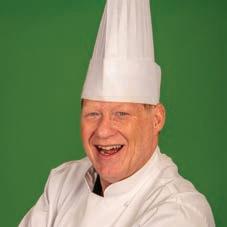

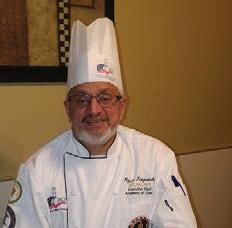
events with the ACFEF Chef & Child Initiative. He has worked with the Give Kids the World holiday project for the past 25 years.
Vice President, Western Region Greg Matchett, CEC
A graduate of the Culinary Institute of America, Chef Matchett has been working in professional kitchens since the age of 13. Currently a Food Fanatics Live™ chef with US Foods, Chef Matchett also has served in executive chef roles in a variety of industry sectors, including luxury country clubs, fine-dining restaurants, five-star hotels, gourmet catering, hospitals, high-end senior living, sports and entertainment, convention centers and food manufacturing R&D. He has cooked for four U.S. presidents and several Fortune 500 company conventions, as well as several large PGA golf tournaments. He has led the opening culinary teams for several restaurants. Chef Matchett also served as a chefinstructor for culinary arts and has coached many student competition teams. Chef Matchett is currently the president of the Colorado Chefs Association and previously served as chair of the Colorado Chefs Association Education Foundation. In 2018, he received the Cutting-Edge Chef of the Year award from ACF. He has three children, ranging in age from 8 to 16.
Immediate Past President Thomas Macrina, CEC, CCA, AAC
Chef Macrina has been a Food Fanatics Live™ chef for the Philadelphia division since 2011. A graduate of the Culinary Institute of America, Chef Macrina’s culinary career began in 1977 as executive chef of the Downingtown Inn Resort in Pennsylvania. He went on to serve in executive chef roles at a variety of other high-end hotels and conference centers. Chef Macrina
| News Bites | WEARECHEFS .COM 9
Chef Rajeev Patgaonkar, vice president, Central Region
Chef Barry Young, vice president, Northeastern Region
Chef Bryan Frick, vice president, Southeastern Region
Chef Greg Matchett, vice president, Western Region
Chef Tom Macrina, immediate past president
is the current chair of the ACF Education Foundation (ACFEF) and previously was elected the ACF national president for two terms, from 2013-2015 and 2015-2017. He also has served as ACF national secretary (2011-2013) and chair of the AAC (2007-2011) and has coached many student and professional chef competition teams; he served as the ACF Culinary Team USA business manager from 2010-2012. Chef Macrina has received numerous awards, including four ACF President’s Medallions, ACF Award for Culinary Excellence and others. He and his wife, Catherine, are the parents of four children and grandparents of five.
American Academy of Chefs (AAC) Chair Americo
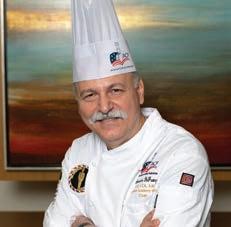
‘Rico’ DiFronzo, CEC, CCA, AAC
Chef DiFronzo is the executive chef of Union Oyster House, which is considered America’s oldest continuously operating restaurant, in Boston. He has served as culinary arts instructor at the Boston University School of Hospitality Administration for the past six years. In 2014, Union Oyster House received an Achievement of Excellence Award from the ACF and has earned many other accolades under Chef DiFronzo’s leadership. Chef DiFronzo’s culinary experience spans 38 years at restaurants in the Boston area, and he has been a longtime ACF member, active at the regional and national levels. He previously served as the AAC’s vice chair and as secretary of the ACF Epicurean Club of Boston for five years. He has received three ACF President’s Medallions and multiple regional awards, including the ACF Northeast Regional Dr. L.J. Minor Chef Professionalism Award twice and ACF Epicurean Club of Boston Chef of the Year, also twice. Chef DiFronzo avidly collects culinary memorabilia, books and photos and has made three donations to the Schlesinger Library’s Culinary Art Collection at Harvard University in Cambridge, Massachusetts.
ACF Culinary Team USA 2024
Chef Kevin Storm, CEC, CCA, AAC, general manager of the ACF Culinary Team USA announced the members of the 2024 team.
The following chefs were selected after three rigorous rounds of tryouts:
• Chef Logan Christensen, CEC, St. Louis Country Club, St. Louis
• Chef Troman Avenido Felizmenio, Waldorf Astoria, Palm Desert, California
• Chef Dan Holtgrave, CEC, Old Warson Country Club, St. Louis
• Chef Ted Polfelt, CEC, CCA, AAC, Virginia Western Community College, Roanoke, Virginia
• Chef Timothy Recher, CEC, AAC, Quail West Golf & Country Club, Naples, Florida
• Chef James K. Storm, St. Louis Country Club, St. Louis
“These chefs exemplify the best of the best,” Chef Storm says. “Over the next four years, team members will devote their time and energy to represent the United States on the world stage. We give great thanks to their employers for supporting the chefs on their journey. Also, thank you to Jones Dairy Farm for their sponsorship of the team.”
Beginning in August, the team will practice together as they perfect their entries for the 2022 Culinary World Cup in Luxembourg, Germany, and for the 2024 IKA Culinary Olympics in Stuttgart, Germany.
10 NCR | JULY/AUGUST 2021 | News Bites |
Chef Americo "Rico" DiFronzo, AAC chair
ACF Regional Award Winners
In a recorded video introduced by Chef Thomas Macrina, CEC, CCA, AAC, ACF national president, and hosted by Chef Rocco Paradiso, master of ceremonies, ACF regional vice presidents presented the regional winners of the Dr. L.J. Minor’s Chef Professionalism Award, the Hermann G. Rusch Chef’s Achievement Award and the Chef Educator of the Year Award. The national winners will be announced during the 2021 ACF Convention in August.
The recipients of the Hermann G. Rusch Chef’s Achievement Award include:
• Chef James Connolly, CEC, CCA, AAC (Northeast Region)
• Chef Roger Newell, CEC, CCE, CCA, AAC (Southeast Region)
• Chef Thomas Recinella, CEC, AAC (Central Region)
• Chef Mohammed “Bobby” Moghaddam, CEC, CCE, AAC (Western Region)
The recipients of the Dr. L.J. Minor Chef Professionalism Award include:
• Chef Joseph Piazza, CEC, CCA, AAC (Northeast Region)
• Chef Timothy Recher, CEC, AAC (Southeast Region)
• Chef Jim Churches, CEC, CCA, AAC (Central Region)
• Chef Christopher DeJohn, CEC, AAC (Western Region)
The finalists of the ACF Chef Educator of the Year Award include:
• Chef Stefan Ryll, CEC, CCE, AAC
• Chef Pamela Bedford, CCE
• Chef Rusty Weatherly
• Chef Earle Test, CEC, CCE, CCA
To watch the full video, visit www.youtube.com/ acfchefs.
As Seen on the Chef’s Table Online Forum…
“More and more programs are [offering Certified Fundamental Cook testing] here in Texas in high school. I had the privilege of serving as an evaluator for these exams, and this young man was about 30 minutes into the exam when I noticed he was shaking and visibly upset. He turned and said, ‘Chef, I can't do this,’ and began tearing up. I took him in the walk-in cooler (the secret counseling closet of all chefs) and grabbed his educator. I spent a few moments encouraging him on his skill set, and then left the decision up to him and his educator as to whether or not he would continue. A few minutes later, he returned to his station and got back into it. Two hours later, I had two composed salad plates and two chicken entrees sitting in front of me, and they were nearly flawless in technique. This kid had some real skills and had just lost sight of that and got in his own head. This is why we do what we do. We educate, we encourage, we serve. As my mentor would say, that is our ‘example of excellence’ to these young culinarians. Proud to be serving alongside all of you.” Chef-Instructor Jason Avelson, CCC, CCE, The Culinary School of Fort Worth, Fort Worth, Texas. Do you have a milestone to share or some exciting news from your career or chapter? We want to hear it all! Email us at pr@acfchefs.net.
ACF Online Learning Center
When you’re not gearing up to learn in person at the 2021 ACF National Convention, check out ACF’s Online Learning Center. There you’ll find NCR quizzes, videos of educational sessions from ACF events, practice exams for certification and more. Visit learn.acfchefs.org to get started.

WEARECHEFS .COM 11
WOMEN WHO LEAD
A discussion with three chefs and one restaurateur about their management styles and philosophies in the kitchen |
By Samantha Lande
Women have been making strides in the culinary world over the past decade, but recent census data shows that only 22.6% of chefs and head cooks in the U.S. are women. That’s despite the fact that women, at least at Johnson & Wales University, now account for about half of a graduating culinary class in any given year. Many culinary programs are starting to tackle this gender disparity with education and mentorship.
That’s not to say there aren’t women in culinary leadership roles, innovating inside their organizations and paving the way for other women looking to follow a similar career path. We spoke with three chefs and one restaurateur to better understand their approach in the kitchen.
MELISSA TRIMMER, CORPORATE EXECUTIVE CHEF, DAWN FOODS GLOBAL, JACKSON, MICHIGAN
Chef Melissa Trimmer spent much of her career as a pastry chef in fine dining restaurants in Chicago before assuming the role of corporate executive chef at Dawn Foods Global, where she heads the culinary team and works with research and development to create the best-tasting baking mixes, as well as other recipes and content. Chef Trimmer is currently the only lead female chef at Dawn and a past chair of the ACF women’s task force.
“There was a time where there weren’t many women in the kitchen,” she says. “There were none in my first ten years working in restaurants. I was European trained. It was, ‘yes, chef,’ and ‘no, chef.’”
Since becoming a manager herself, Chef Trimmer has chosen to run her kitchen in a more collaborative way, opting for a leadership style that gives everyone a seat at the table and a voice to be heard.

12 NCR | JULY/AUGUST 2021 | Management |
Chef Melissa Trimmer
“For instance, there is someone on our team that knows far more about bread,” she says. “Whenever there is a project involving bread, we look to her for expertise.”
Pressure can be less intense in a corporate kitchen, but COVID-19 added stress for everyone. Given that Dawn is considered foodservice, many employees continued to work in person, watching industry peers lose jobs and restaurants across the country close.
During COVID-19, when there was added stress for everyone, Chef Trimmer continued to cook a big family meal for her team to help with team morale, as well as alter her game plan — trying to inject humor where she could and come up with socially distanced team-building activities.
“We participated in ACF’s virtual convention together — socially distanced — as career development,” she says, “and it made us all feel just a little bit better.”
In her day-to-day job, staying organized with a structured calendar allows Chef Trimmer to better ensure everyone on the team is doing what they need to be doing. Most importantly, her leadership role allows her to change the perception of women in the kitchen in a positive way. “It’s really important to reach out and elevate other women,” she says. “Not everyone feels comfortable speaking up for themselves.”
MARGARET OCCHIPINTI, SENIOR DIRECTOR OF CULINARY, LIFEWORKS RESTAURANT GROUP, PHOENIX
In her role, Chef Margaret Occhipinti oversees business dining, on-site restaurants and food halls across the country and is responsible for all aspects of culinary, including concept and recipe development, identifying product specs, hiring and training, guest experience, food quality, food safety and more. She manages three senior executive chefs and 14 executive chefs and their teams across seven campuses.
With so many different people to manage, Chef Occhipinti takes a personalized approach to leadership. “In my experience, the more that you invest in your team, the more you get back in terms of quality, drive and productivity,” she says.
Chef Occhipinti does this by meeting regularly with her team members — having coffee or lunch one-on-one before COVID-19 (and hopefully again soon when safe to do so) — to discuss challenges and opportunities.
“I make it a priority to know everyone’s name and care about their lives and their goals,” she says. “It’s also important to give honest feedback, both positive and constructive.”
By getting to know her team well, Chef Occhipinti is able to approach tough topics with ease. She approaches everything with honesty, whether it’s being empathetic toward others when it comes to fears about COVID-19, dealing with a performance issue or encouraging safe kitchen practices.
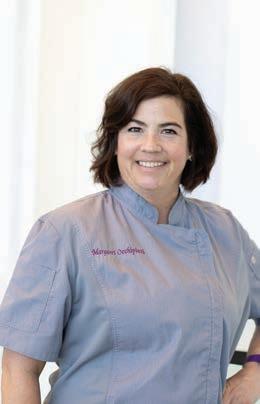
It’s not all tough stuff. Chef Occhipinti tries to create a culture that is upbeat, fun and creative.
“An atmosphere that is fun and whimsical helps to keep the creative juices flowing and the energy high,” she says. “I encourage our team to take a risk, to go with that crazy idea — you never know what is going to be the next great thing.”
Chef Occhipinti also makes sure to involve everyone in the menu creation process.
“I typically work with the executive chefs to set the structure and talk about what is trendy, seasonal and a good fit for our restaurants,” she says. “The chefs have autonomy to write their menus and recipes, and I review and oversee implementation.”
WEARECHEFS .COM 13
Chef Margaret Occhipinti
Culinary Math


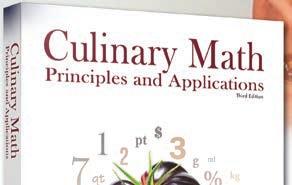



AMY MORTON AND DEBBIE GOLD, AMDP MANAGEMENT, EVANSTON, ILLINOIS

For restaurateur Amy Morton and Executive Chef Debbie Gold, female leadership doesn’t feel like an anomaly: It’s what they know. Their general manager, director of private events, sous chef and public relations team are all female.

“When women are working together, it’s not about, ‘Look at how good I am.’ It’s really more about, ‘We are doing this together — how do we make it work for everybody?’” says Chef Gold, who adds that she and her team are all about putting egos aside.
Morton agrees: “Female chefs, owners and management teams tend to want to work together, and this helps build better relationships. There is an innate sense of support and communication, and that makes [collaboration] really easy.”
Though Chef Gold spends most of her time at Found, one of Morton’s restaurants in Evanston, Illinois, she also occasionally checks in with kitchen teams at the other restaurants: The Barn Steakhouse, also in Evanston, and Stolp Island Social in Aurora, Illinois.

“We have some talented chefs and sous chefs we rely on,” Chef Gold says. “I don’t want to micromanage if I don’t have to, so we fill [our teams] with hardworking, talented people.”
When it comes to protocols and culture, Chef Gold tries to maintain consistency across all restaurants, but at the end of the day, the philosophy is simple. “I want people who want to come to work, even if the hours are long and work intense,” Chef Gold says. “At the end of the day, we are there to service the guest. It doesn’t matter what position you are in.”

That mentality served the team well when COVID-19 hit, as Morton and Chef Gold prioritized their staff and guests like they would family when it came to safety and support.
“By doing this, we really gained our teams’ trust and our guests’ trust and grew our marketplace by doing different things,” Morton says. “We really tried to create ways to give them work and keep as much of our team employed as possible.”
14 NCR | JULY/AUGUST 2021
Samantha Lande is a freelance writer based in Chicago. Her work has appeared in Food Network magazine, Allrecipes, Real Simple, and other local and national publications.
From left: Amy Morton and Chef Debbie Gold, AMDP Management.
Lower costs, increase guest satisfaction, and improve profitability. The
Kitchen Tool Learn about ATP’s training materials for sharpening your team’s culinary math skills. Visit https://info.atplearning.com/ culinary-math 1-800-323-3471
Other Essential
Let your customers know you have their safety in mind.
New ACF COVID-19 Safety Training
Take the ACF COVID-19 Safety Training for Foodservice course and earn a certificate and verifiable digital badge that can be displayed on your website and social media channels.

Available in the ACF Online Learning Center. Visit acfchefs.org/OLC
Topics Covered:
• Key Features of COVID-19
• Minimizing Risk and Preventing Spread

• Best Practices for Foodservice
• Examples from Chefs in the Industry
YOUR 2021 ACF NATIONAL CONVENTION HOST CHAPTER: ACF CENTRAL FLORIDA
The Value of a Good Hosting Playbook // By
Lynda Alfano, Director of Marketing
Conventions are finally back! The ACF Central Florida chapter is so excited to welcome you once more to “The City Beautiful.” Orlando is a pretty experienced city when it comes to conventions. Our chapter has a wealth of knowledge gleaned from years of convention-hosting experience that I would like to share with you for future events.
When I heard about our board members assembling the 2021 Convention Host Committee, I wanted to learn more about our approach to hosting the ACF National Convention. I knew the best source for this would be the man who’s helmed almost all of our convention hosting opportunities: Chef Roger Newell, CEC, CCE, CCA, AAC. Here’s what we discussed. What is the first thing we do when our chapter is selected to host an ACF national convention?
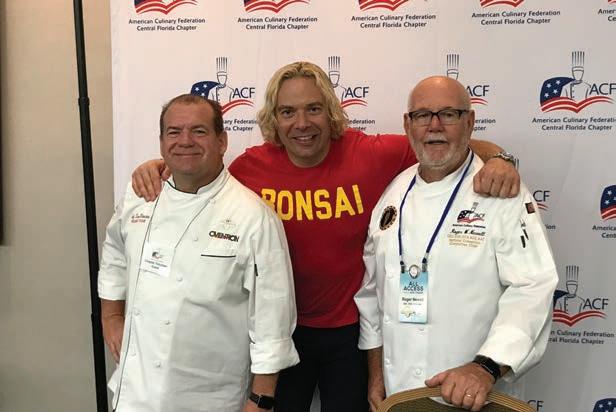
RN: We dust off our binder. Our chapter has been fortunate to host eight ACF national conventions. We learned early on the value of a good playbook. Every convention is different with
new themes and new speakers. So hosting requires a new plan, but a playbook gives us a good start. Everything is in the book. No detail is too small to be left out. From signage to shuttle vans, I guarantee you it’s in the binder. Your experience as a convention chair gives you great insight. What is the first question other chapters ask you when they are selected to host for the first time?
RN: They always ask, ‘Where do I start?’ And I always answer with, ‘It all starts with a great team.' You can’t do it alone. You need those people that will show up. These people will be your event committee, and they will help you cover all of those little details that go into hosting a big event like the ACF National Convention. But I also caution against overloading your people. Don’t burn them out.
Volunteers must be a huge help for that. Where do we find enough people for an event this large?
RN: Volunteers can be challenging to find. Over multiple conventions and several annual community events, we’ve tapped into our membership a lot. So we’ve had to think creatively in this area. Our chapter sponsors have employees that love to help. Florida ProStart high schoolers are always in need of volunteer hours. Local culinary programs look for industry opportunities for their students. And don’t overlook your fellow ACF chapters near you. We’ve had ACF members from as far away as North Carolina sign up to volunteer time at the Orlando show. What will attendees find at the ACF Central Florida chapter’s table this year?
RN: We are definitely bringing back our huge map of the United States. We give each attendee a pin, and they push it in over their home city. We love seeing how far and wide the ACF members come from. It’s a nice visual reminder that the ACF brings us all together to celebrate like this.
16 NCR | JULY/AUGUST 2021 | Chapter Close-Up |
Pictured left to right: Chef Tim Klauder (chapter volunteer), Eric the Trainer, and Chef Roger Newell (convention committee chairman).
What’s your personal favorite part of hosting the ACF National Convention?
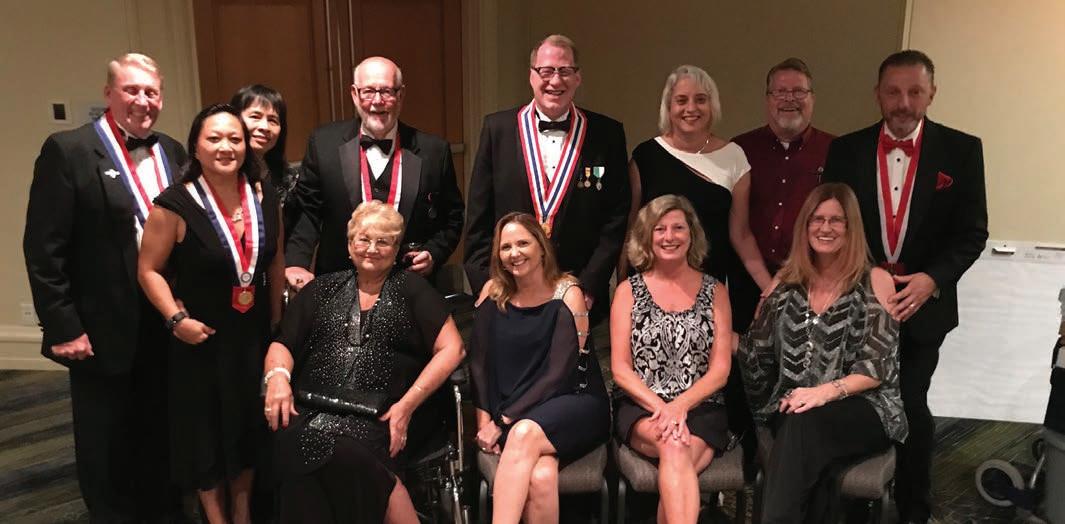
RN: I love our 50/50 raffle. That’s been a huge success. The last time we hosted two years ago, the winner went home with almost $4,000 in cash. That means our chapter’s portion gave us a healthy start to that year’s student scholarship fund. Years ago, our board was searching for something that convention attendees could get really excited about. We didn’t want T-shirts or mugs. We wanted fun and exciting. We once even had Eric the Trainer do pushups in front of our chapter table to raise money for the 50/50 raffle. It just seems to draw enthusiasm from people. And we typically add in daily prizes for more winners.
I think this is a good time for a shameless plug, Roger. Are we doing our 50/50 raffle this year?
RN: Absolutely! We’re selling tickets at our chapter table every day of the show for $5 each, or five for $20. And the great part is how easy it will be to buy bundles of raffle tickets this year. Through the wonders of technology, we’ll be able to enter your name and cellphone number digitally and have that information printed directly on however many tickets you want to buy. No more time spent handwriting your name on every ticket stub. It couldn’t be easier this year.
Any last advice to other chapters about hosting an event like this?
RN: Yes, plan ahead and give yourself the best gift of all: time. And finally, any last advice to those preparing to come to Orlando for the 2021 ACF National Convention in August?
RN: Come ready for a great time. We’ve all been cooped up for a year, and we’re ready for food and fellowship. Bring your suntan lotion and shades. And don’t forget to bring money for the 50/50 raffle.
[On behalf of the ACF Central Florida chapter, we can’t wait to welcome you to Orlando. Come ready to get inspired and ignite your culinary passion. See you soon!]
WEARECHEFS .COM 17
2019 ACF/CFC Convention Committee members and volunteers all dressed up and ready for the gala. Pictured left to right (Top row): Chef Philip Guilbeault, CEC, AAC; Chef Nora Galdiano, CEC, AAC; Chef Dut Nguyen; Chef Roger Newell, CEC, CCE, CCA, AAC; Chef Bryan Frick, CEC, AAC; Kathy Proisl; Chef Marcus Herrington, CEC; Chef Joe Alfano, CEC, AAC. Pictured left to right (Bottom row): Debbie Newell; Jane Frick; Laura Herrington; and Lynda Alfano.
MOBILE FEASTS FIND NEW FOOTING
How food truck operators continue to feed hungry customers in the aftermath of the pandemic
By Liz Barrett Foster
While most brick-and-mortar restaurants were forced to close during the coronavirus pandemic, food trucks were largely allowed to remain open since they serve food outside.
The ability to stay open, however, wasn’t enough to save the 22.5% of food trucks that permanently closed this past year, according to third-party research firm Datassential. In fact, the firm reports that food trucks were the sector of foodservice worst affected by the pandemic.
According to Matt Geller, founding president of the National Food Truck Association, “Office lunches are the bread and butter of a lot of food trucks in big cities like Los Angeles and Manhattan. With those offices closed and downtowns left empty, many of those food trucks were forced to close.”
Some food trucks were able to transition, in some capacity, from serving office workers to setting up shop at retail centers or in residential neighborhoods while the nation ground to a halt. For the food trucks
that have remained open, operators have turned their focus to tighter menus, stricter sanitation practices and catering to individual businesses and events.
Food trucks in smaller cities appear to be faring better than those dependent on office foot traffic, according to Geller. He says more truck operators are open to online ordering and preorders than they were before the pandemic.
FORGING A NEW PATH
Chef Daniel Bloom serves thin-crust pizzas from a pirate-themed menu out of his wood-burning oven on DB’s Rolling Dough, based out of Gainesville, Florida. When events were canceled during the pandemic, Bloom says he found a new customer base at barrel racing rodeo events. People were happy to find someone willing to come out to their event and feed them when no one else would.
Chef and former culinary instructor Jenny Castor has been running her Luckybee Kitchen food truck for
18 NCR | JULY/AUGUST 2021 | Main Course |
five years in Fort Worth, Texas. She changes her menu on a daily basis and counts on private, prepaid events for most of her business.
Chef Brett Novick runs a restaurant and two food trucks under his Boxcar Burgers brand in Brunswick, Maryland. One of the trucks moves around while the other is stationary at the same brewery six days a week. Novick says that 90% of his food truck business consists of breweries and wineries. “We show up when we’re supposed to and don’t pay any money to be there,” Chef Novick says. “Some places we’ll give staff a discount or feed the bartenders, but for the most part, no money changes hands.”
MINDING MENUS
With more than 25,000 food trucks in America, according to market research firm IBISWorld, there’s also a wide range of cuisines from which to choose. And while many trucks offer a standard menu seven days a week, chefs like Castor enjoy changing things up depending on the demographic or event. “I believe the consumer has an expectation of a more playful or
exaggerated take on food when they come to a food truck,” she says. “Eating off a food truck should be a delight, and personally, I love to push the boundaries.”
Chef Castor’s menu has featured items such as a smoky shrimp omelet; grilled peach and brie waffle; cheeseburger salad; and a candied bacon BLT.
While everyone agrees that food truck fare needs to be quick and easy to package for carrying and eating while mobile, Chef Novick says that over the last four or five years, he’s seen a change in consumers’ attitudes. People previously expected only barbecue or concession-style food from a food truck but now anticipate any cuisine. At the same time, Novick concedes that one of the jokes among food truck owners is that no matter what kind of food you’re selling, people will ask if you have barbecue or tacos. The menu at Boxcar Burgers includes grass-fed locally sourced beef burgers, hot dogs, an Impossible plantbased burger and fresh hand-cut French fries.
And while food truck customers are excited about the new, creative food being offered from food truck vendors, Chef Bloom says that his menu items
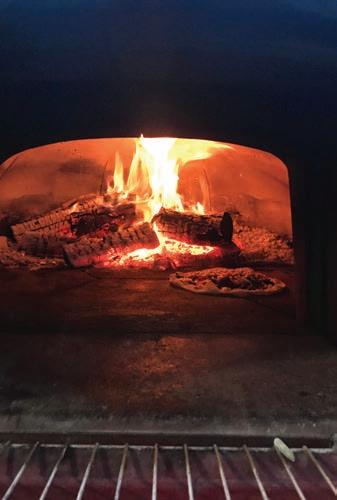


WEARECHEFS .COM 19
Above: Chef Daniel Bloom. Right: DB's Rolling Dough, a food truck in Gainesville, Florida, that serves thin-crust pizzas with a pirate-themed menu.
often prompt conversation or laughter. The DB’s Rolling Dough menu features nine permanent pizzas and one weekly “booty,” sticking with the pirate theme. “It’s always funny when someone comes up and says, ‘I could use a weekly booty,’” he says.
When Chef Bloom’s menu isn’t creating chuckles, it can also inadvertently cause confusion. “I have a pizza called the Black Pearl that’s topped with spinach, mushrooms and finished with white truffle oil,” he says. “A few times, I’ve had people ask me if I could hold off on putting chocolate on the pizza.” For Chef Bloom, he says part of the fun of operating a food truck is the freedom to expand people’s palates and introduce them to new ingredients through creative menus.
WHEN MINUTES MATTER
No matter how creative or delicious the food coming off of a food truck is, customers still expect it to be fast.
Chef Castor says she has three rules with the food she makes on her truck. “It must taste amazing, it must look amazing, and it must get out the window in under seven minutes,” she says. “It starts with choosing around five ingredients with big flavors, excellent mise en place and a big imagination.”
Chef Novick, who comes from a brick-and-mortar restaurant background, says he appreciates when his cooks want to add more items to the menu, but it’s often not feasible from a timing standpoint. It’s one of the reasons he says he chose hamburgers for his truck. “I love hamburgers, they have universal appeal, and they’re quick,” Chef Novick says. “A lot of commissaries charge by the hour, too, and hamburgers don’t require much off-truck prep.”
TOUCH POINTS
At the start of the pandemic, scientists weren’t sure whether COVID-19 was passed along through food. Since serving food is so hands-on, stricter sanitation and serving practices were adopted by all foodservice establishments, including food trucks.
Chef Castor says that with the pandemic, sanitation was taken to a new level. “As soon as the pandemic hit, I knew that we’d have to adapt with additional protocols to make the consumer feel confident and comfortable eating off my truck,” she says. “Masks, gloves, employees assigned to handle money, contactless payments, hand sanitizer for guests — I even turned my truck into a ‘drive-thru’ early on.”
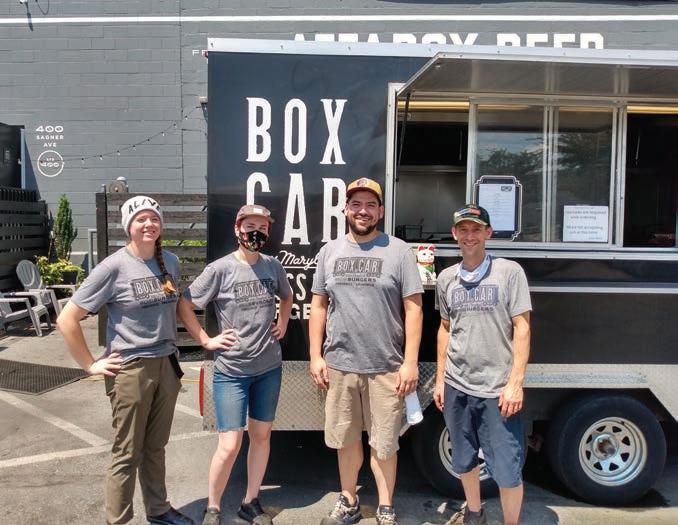
20 NCR | JULY/AUGUST 2021 | Main Course |
Chef Brett Novick and his crew from Boxcar Burgers, a brand featuring a restaurant and two food trucks in Brunswick, Maryland.
Similarly, unless you’re operating a vegan or gluten-free truck, the small spaces inside a food truck make it nearly impossible to protect against some cross-contamination. “It doesn’t make me happy to say, ‘I can’t feed you,’” Chef Novick says, referring to strictly vegan guests or those with celiac disease. “But it’s the reality of what we’re working with in terms of the size of our kitchen.”
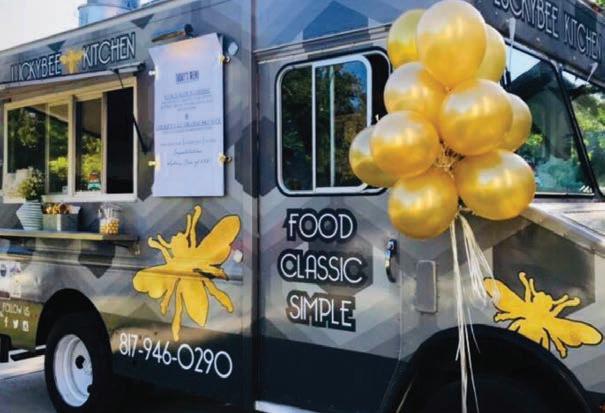
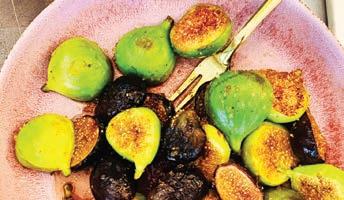

Chef Bloom says that, in some ways, the pandemic was good for food trucks. Some people who had never tried food trucks before were introduced to them and got a chance to see food cooked in front of them and handed safely out a window. Those customers now realize food trucks are safe, sanitary and put out delicious food.
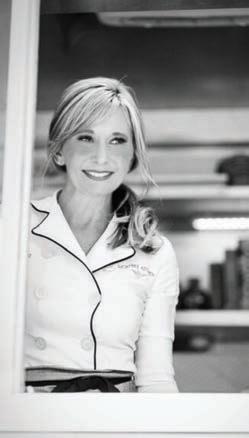
WEARECHEFS .COM 21
Above and left: Chef Jenny Castor and her food truck, Luckybee Kitchen in Fort Worth, Texas. Right (top): Candied cinnamon and turbinado figs. Right (bottom): Blood orange with Lebanon bologna, goat cheese, pepper, misocarrot vinaigrette and pistachio.
Liz Barrett Foster is an award-winning B2B journalist, food writer and editor of EatLikeaWriter.com.
EQUIPPING A FOOD TRUCK
Start small and let your truck grow with your business
By Liz Barrett Foster
Have you ever had your oven overheat, your refrigeration stop working or the electricity fail? Now imagine any of these scenarios happening while you’re pushing food out of a 10-foot food truck trailer with a line of 20 people waiting outside your window.
Everything is smaller in a food truck, including the space in which you and your staff have to work. Keeping the setup and equipment simple is key when planning a food truck venture, according to most successful food truck operators. It also helps if you’re comfortable rolling up your sleeves to fix equipment that might fail halfway through service. “I can’t tell you how many times I’ve fixed water pumps and hot water heaters on the fly,” says Chef Brett Novick, owner of Boxcar Burgers in Brunswick, Maryland. “Equipment is not built specifically for food trucks, so things break with the movement and temperature changes of a truck.”
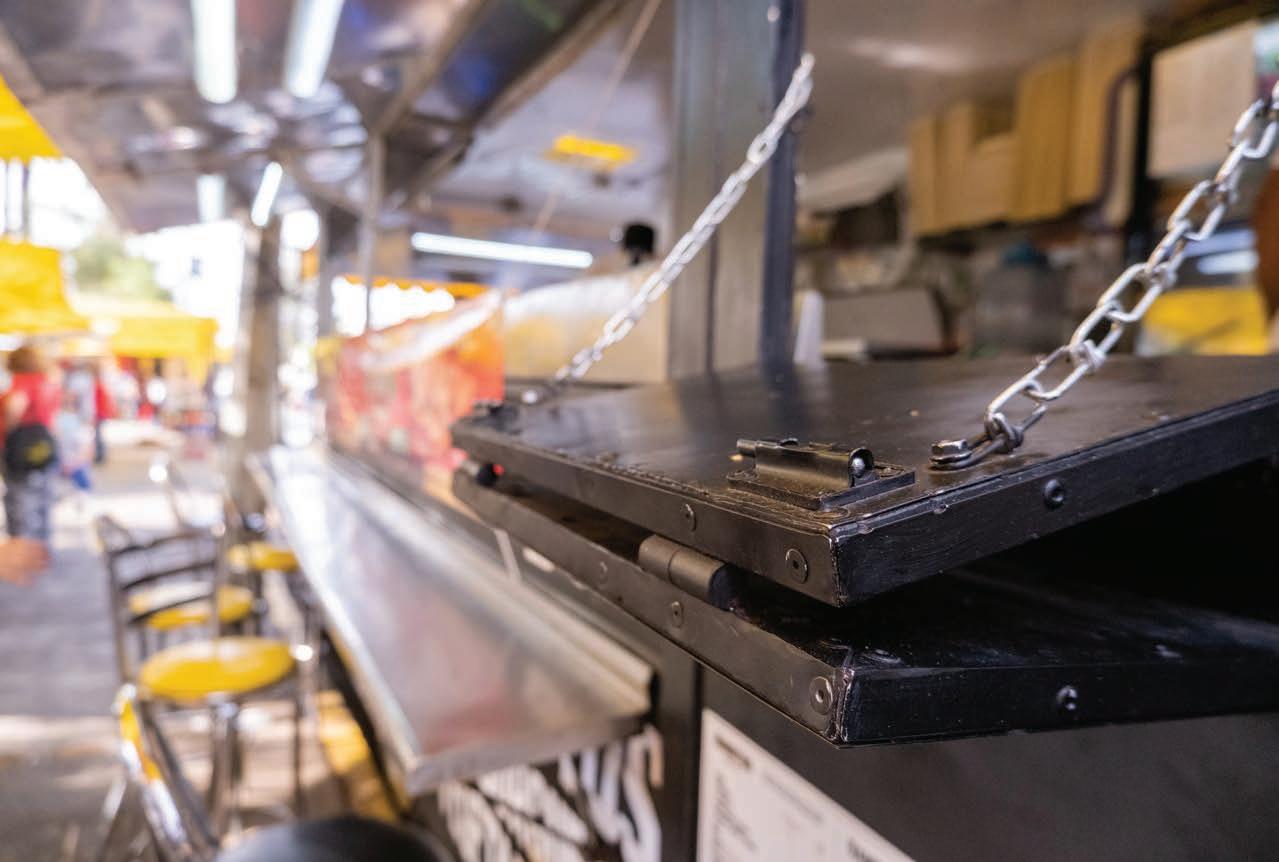
22 NCR | JULY/AUGUST 2021 | On the Side |
Depending on the size of the truck and the type of cuisine being served, Chef Jenny Castor, owner of Luckybee Kitchen in Fort Worth, Texas, recommends, at minimum, a quality flattop, two burners, refrigeration and a small fryer. “The health department in your area will dictate the requirements for a hand washing sink, three-compartment sink, vent hood and other mandatory equipment,” she says. “A truck, by law, must also have hot and cold running water on board.”
As for electricity, not all food truck vendors spring for their own generators, but Chef Castor says that a quiet, trustworthy generator will pay for itself when you discover the opportunities that open up when you’re able to supply your own electricity.

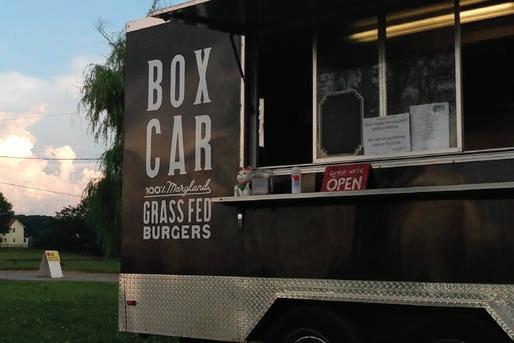
Before spending any money on a food truck venture, Chef Novick suggests contacting your local fire marshal and health department inspector to discuss your plans and your menu. “Familiarize yourself with the regulations in your area before you spend a lot of money,” he says.

For those wanting to test out an idea before investing in a lot of equipment, Chef Daniel Bloom from DB’s Rolling Dough, based in Gainesville, Florida, says he started out with a couple folding tables, a couple coolers and his wood-burning oven. “Starting small is sometimes the best way, more often than not,” Chef Bloom says. “As you grow, you’ll learn different techniques, and that’s a big benefit.”
Whether you plan to start your mobile food business with a folding table or a fully customized rig, choose the equipment that makes the most sense for your specific menu and your current budget.
WEARECHEFS .COM 23 | On the Side |
"STARTING SMALL IS SOMETIMES THE BEST WAY, MORE OFTEN THAN NOT. AS YOU GROW, YOU'LL LEARN DIFFERENT TECHNIQUES, AND THAT'S A BIG BENEFIT."
-CHEF DANIEL BLOOM
From top: Luckybee Kitchen in Fort Worth, Texas; DB's Rolling Dough in Gainesville, Florida; Boxcar Burgers in Brunswick, Maryland.
FROZEN DESSERTS
Tasty ways to beat the heat // By
Robert Wemischner
On a hot summer’s day, what’s more refreshing than a scoop of ice cream, sorbet or gelato or even a baked Alaska with its contrasting flavors and textures on a plate? When the weather turns hot and the humidity index rises, nothing satisfies — and brings out our inner child — better than a frozen dessert. Today’s chefs are experimenting with a wide variety of global flavors, techniques and variations on our favorites.
Fun with Flavors
Talk to Chef Chris Broberg, gelato and sorbet maker for FlagShip Culinary Services in New York City, who spins a rotation of 12 to 18 flavors a day for the office workers at a tower near Union Square.

The former longtime restaurant and hotel pastry chef has offered unique flavors such as saffron, pistachio, durian, mellow red bean and more. “My flavors appeal to a younger metropolitan adventuresome audience,” he says. The ice creams are served in gluten-free cones made on the premises, along with gluten-free biscotti.
“What’s nice is that I am not making products for extended shelf life, and I am blessed to get to use the ingredients that I want to use,” Chef Broberg says. “I choose what goes on the rotating menu, influenced by a certain seasonality. We even base some of our flavors on holidays from around the world.” The worldfamous Union Square Greenmarket also serves as inspiration for his creations.
Global Inspiration
Traveling to the Left Coast, Chef-Owner Adrienne Borlongan, of Wanderlust Creamery (now with four locations throughout greater Los Angeles), follows in the footsteps of her grandfather, who was a flavor chemist for a Breyers branch in the Philippines. Chef Borlongan features on her menu halo-halo, an iconic Filipino dessert made with a variety of fruits, sweetened white beans, condensed milk and shaved ice that’s typically topped with purple yam (ube), crème caramel and ice cream. Her Pretty in Purple flavor is a mashup of South Asian flavors and American invention that combines crunchy malted milk balls, ube and malted milk. Pandan Tres Leches is made from the crumbs of housemade sponge cake with ribbons of condensed milk.
24 NCR | JULY/AUGUST 2021 | Pastry |
Chef Chris Broberg, gelato and sorbet maker for FlagShip Culinary Services in New York City.
“I named the company Wanderlust as a reflection of places where I have gone and those still on the bucket list,” says Chef Borlongan, who showcases other ice cream flavors such as mango, cheddar cheese and Palestinian knafeh, a shredded filo-based pastry usually soaked in orange blossom syrup with a traditional cheese-based filling (she uses ricotta and mozzarella in her version) that’s folded into the ice cream base. The final touch here is a generous studding of pistachios throughout the mix, giving a nod to both California and the Middle East — two areas with major pistachio production.
Chef Borlongan’s ice creams tend to resemble gelato in texture. “It’s denser with little overrun,” she says. “We freeze all of our ice creams until they are very hard, and then they are tempered in our dipping cases so that they are easy to dip but won’t melt as quickly once handed over to the customer.”
Chef Ria Dolly Barbosa, executive chef and partner at Petit Peso, a downtown Los Angeles cafe featuring Filipino food, also makes traditional halohalo. But she adds coconut milk ice cream, along with passion fruit gelee, pink guava syrup and toasted coconut. “Here, in one dessert, is a glimpse into the signature flavors of the Filipino pantry with a whole jumble of textures and temperatures that make the flavors irresistible,” she says.

Opposites Attract
Chef Sylvain Marrari, executive pastry chef at The Villa Casa Casuarina, housed in the old Gianni Versace mansion in Miami Beach, Florida, combines hot and cold in a variation on the omelette norvégienne, a Norwegian dessert “omelet” layering cake, ice cream and meringue that legend says might have been the inspiration for baked Alaska, first documented in Fannie Farmer’s “The Boston Cooking-School Cook Book,” published in 1896.
“In the hot and sometimes humid weather here, frozen desserts are popular,” Chef Marrari says. “And from the pastry chef’s point of view, they are convenient as they can be made in advance, with only the need to add finishing touches just before it is served.” For his ice creams, Chef Marrari follows a classic pâte à bombe method, whisking egg yolks while streaming in a hot sugar syrup. He then folds
in whipped cream and freezes the mix. This still — rather than stirred or turned — method is particularly well suited for molded desserts, such as a baked Alaska. Here, it is garnished with torched Italian meringue and the Villa’s signature embossed chocolate coin covered in gold dust.
“I love the balance between sweet, hot and cold, but I think that the key is to introduce something acidic or tart like passion fruit into my version, which pays homage to a fruit that grows practically wild in Florida,” Chef Marrari says. “I’m convinced that the palate never gets tired of something both frozen and tart. Plates with these simple but complexly flavored desserts always come back to the kitchen clean.”
WEARECHEFS .COM 25
Halo-halo from Petit Peso, a cafe in downtown Los Angeles.
Robert Wemischner is a longtime instructor of professional baking at Los Angeles Trade-Technical College and the author of four books, including “The Dessert Architect.”





























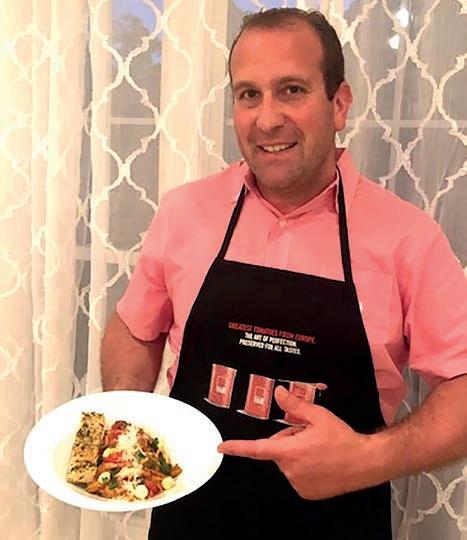
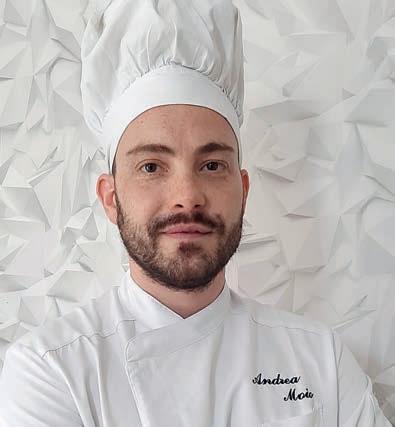



































Classical
Chef Jeffrey Schlissel, executive chef of Locale Gastropub & Test Kitchen in Lake Park, Florida, and owner of Bacon Cartel, a chef-driven smoke shop, remembers his first encounter with a classic salad Niçoise: watching Julia Child make it on television when he was 10 years old. “I thought, who would eat that? But I was young, maybe 10 or 12 at the time. What did I know?” he says. “Through the years, I have seen interpretations of this classic — even seeing canned tuna used in a pinch.” Two years ago, a friend challenged Chef Schlissel, who is passionate about everything barbecue, to take a classic French dish and “BBQ-ify” it. His choice? The salad Niçoise, of course. Chef Schlissel used a smoking gun to add a component of smoke to the dish and for a quick sear without overcooking the tuna. Chef Schlissel has grown to love the elegance and simplicity of this salad with its endless opportunities for variation.

28 NCR | JULY/AUGUST 2021 | Classical vs. Modern |
Modern
As Chef Schlissel became more interested in plant-based cooking and opened Locale Gastropub & Test Test Kitchen — which is favored by vegans and non-vegans alike — he considered making a fishless version of the salad Niçoise. “I wanted to push the boundaries of what people think they see, smell and taste, but in the end, nothing they ate came from an animal,” he says. “I also wanted to keep the dish in the parameters of our farm-to-table theme.” In lieu of rare tuna, he chose watermelon, which is grown locally in Florida and could offer that same bright reddish color. Chef Schlissel used his trusty blowtorch to first char thin slices of the fruit, just like he seared the tuna. He then made a hard-boiled “egg” out of tofu, agar-agar, nutritional yeast and potato flakes, shaped using silicone molds. A touch of furikake added that umami that the tuna would otherwise provide. He then added more vegetables in the form of colorful, poached fingerling potatoes, blistered tomatoes, marinated olives and blanched haricot vert, topping off the composed plate with a few drops of tangy shallot vinaigrette and a pinch of French sea salt. “How did you get the egg to taste like egg?” one diner asked. “I even had a vegan complain that the ‘tuna’ was too fishy. I take that as a compliment.”
See the classical and modern recipes, as well as more photos, at wearechefs.com .

WEARECHEFS .COM 29
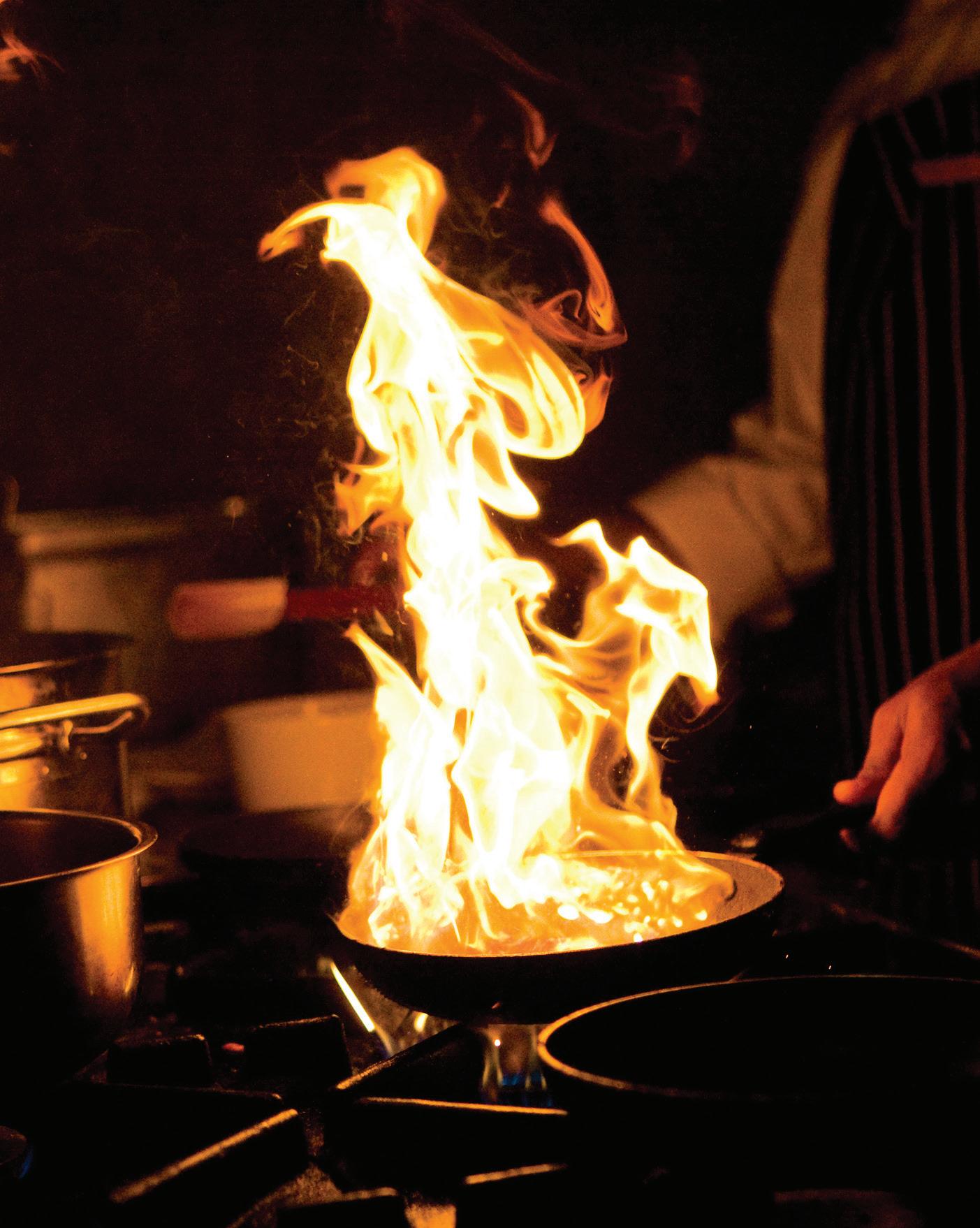
30 NCR | JULY/AUGUST 2021
ACF NATIONAL CONVENTION
Two Master Chefs Discuss Our Industry in Today’s Time
Chef Edward Leonard, CMC, AAC, director of culinary/executive chef at Fresh Meadow Country Club in New York and partner/vice president of culinary for the Master Chef Institute, will share his powerful message about culinary leadership. During this important session, Making a Difference Through Food & Hospitality, Chef Leonard, a past ACF national president, will explain which qualities all chefs must hone and describe how, when those skills are combined with innovation and commitment, they can ensure success — even in challenging times. Chef Joseph Leonardi, CMC, AAC, director of culinary operations at The Country Club in Chestnut Hill, Massachusetts, will open the 2021 ACF National Convention with a powerful discussion about the struggles chefs currently face in our industry. His presentation, Behind the Plate Up, will touch on hot topics for culinary leaders, including employee retention, working out of your comfort zone and more. To read more about these maste chefs, visit acfchefs.org.
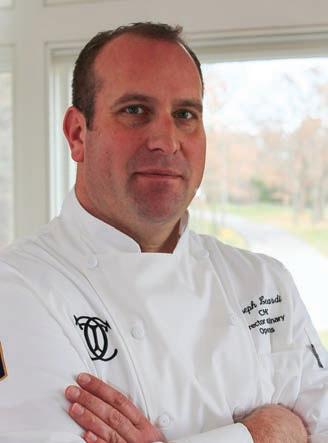
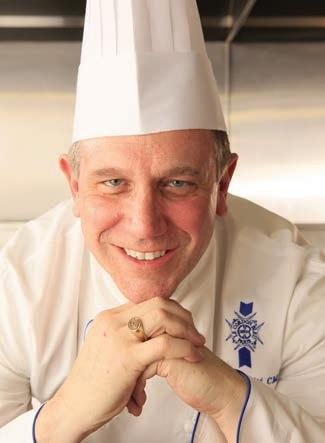
WEARECHEFS .COM 31
After last year’s pandemic moved everything online, this year’s in-person event is poised to be more exciting than ever. //
By Amelia Levin
Left: Chef Edward Leonard, CMC, AAC; Right: Chef Joseph Leonardi, CMC, AAC.
Two Celebrity Chefs to Deliver Keynote Presentations
Chef Art Smith
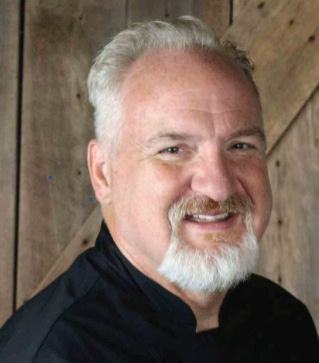
A sixth-generation Floridian, restaurateur and TV personality Chef Art Smith is famous for his fried chicken and celebrity clientele. The twotime James Beard Foundation award winner — and former personal chef for Oprah — has led an exciting career that includes running celebrated restaurants in Orlando, Chicago, Atlanta and Washington, D.C. Television viewers know him from the "Today" show, "BBQ Pitmasters" and "Top Chef Masters." Chef Smith, who currently resides in Jasper, Florida, will share an inspirational message on success and overcoming adversity.
Chef Carla Hall

A native of Nashville, Tennessee, Chef Carla Hall first pursued a business route, graduating from Howard University School of Business and working as an accountant before switching gears to become a runway model. Today, she is a trained chef who has worked in several professional restaurant kitchens in and around the Washington, D.C., area and is an accomplished TV personality and author. Chef Hall first won over audiences when she competed on Bravo’s “Top Chef” and “Top Chef: All Stars” and later spent seven years co-hosting ABC’s popular Emmy Award-winning lifestyle series “The Chew,” among other shows. She will discuss the many pivots chefs had to take during the pandemic and how to continue learning on the job.
A Thank You to ACF’s Many Volunteers
“Our volunteers are extremely valuable, and without their commitment and passion for the betterment of our industry, we would not be able to fulfill our goals and certify chefs, accredit schools and execute competitions. We realize that completing all of the requirements to remain an active volunteer takes time. Volunteers are the lifeblood of our organization, and while it is your choice to continue to serve, I hope you understand that ACF needs to uphold our requirements and support our standards.”
– ACF President Thomas J. Macrina, CEC, CCA, AAC, ACF
32 NCR | JULY/AUGUST 2021 | 2021 ACF National Convention |
Chef Art Smith
Chef Carla Hall
Spotlight on Gullah Geechee Food with Chef Matthew Raiford
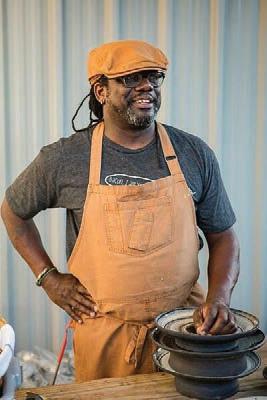

From hot buttermilk biscuits and sweet potato pie to fish stew and salmon cakes over pepper rice, Gullah Geechee food is an essential cuisine of American history that’s documented in Chef Matthew Raiford’s newly released book, “Bress ’n’ Nyam: Gullah Geechee Recipes from a Sixth-Generation Farmer.” From the Carolinas to Georgia and Florida, this is where descendants of enslaved Africans came together to make extraordinary food, speaking the African Creole language called Gullah Geechee. Chef Raiford grew up breaking the dirt and trading crookneck squash for sweet potatoes, raising hogs and chickens and only going to the grocery store for sundries. Following a military career, Chef Raiford graduated from the Culinary Institute of America in Hyde Park, New York. He returned to the farm in 2011 to continue the traditions of his Gullah Geechee heritage and to create an authentic farm-to-fork experience for locals. He received certification as an ecological horticulturalist from the University of California’s Santa Cruz Center for Agroecology and Sustainable Food Systems. At the 2021 ACF National Convention, Chef Raiford will go into more detail about this culinary representation of the ocean, rivers and rich fertile loam in and around the coastal South. He also will discuss the important connection between soil health and the taste of food. For a Gullah recipe, visit WeAreChefs.com.
Up Close with Chef and Career Coach Duane Brown
Chef Duane Brown founded Culinary Coach, LLC, as a coaching, mentoring and training program for up-andcoming chefs, including recent graduates, early- to mid-career shifters, previously incarcerated individuals and others looking to get their footing in the culinary industry. As the current director of workforce development for Church Hill Activities & Tutoring in Richmond, Virginia, he facilitates some of this training at an on-site café and restaurant run by the nonprofit, which serves the youth of Richmond’s East End community.
During his presentation, Culinary Careers: The PostCOVID Pivot , Chef Brown will discuss how to identify long-range goals and how chefs can pivot following this

challenging year. “The questions for many have been: Do you have a strong desire to stay in this industry, or do you want to make a more significant change in the industry or focus on a different aspect of the industry?” Chef Brown will identify many avenues in the culinary world beyond traditional restaurants, including pathways in distribution and sales and research, as well as emerging opportunities with new companies, such as meal kit and technology solution providers. He will also discuss how to reshape and enhance a company or organization’s culture.
“Culture is going to be huge in the future,” Chef Brown says. “No one wants to work in a toxic environment anymore. Those restaurants and companies with a healthy culture that run their business efficiently and fairly to all will be the ones to survive and succeed.” Chef Brown holds a master’s degree in organizational leadership and a bachelor’s degree in culinary arts management from the Culinary Institute of America in Hyde Park, New
York.
WEARECHEFS .COM 33
Chef Matthew Raiford and his Effie’s Shrimp Creole from “Bress ’n’ Nyam: Gullah Geechee Recipes from a Sixth-Generation Farmer.”
More Convention Sessions and Speakers
Chef Michael Ponzio, executive chef of the Union League Club of Chicago, has drawn a strong following on Instagram after experimenting and regularly posting videos of himself cooking different — very delectable — dishes offered at the club. In his presentation, Rebuilding a Stronger Culinary Brand , Chef Ponzio will share tips and techniques for growing your social media and follower base for a low-cost, low-effort marketing strategy. Follow him on Instagram @chefponzio.
Join Chef Hari Pulapaka, CEC , for an important session, A Delicious and Sustainable Future For Foodservice, as he guides an exploration of creative ways in which chefs and the hospitality industry can reduce food waste while promoting healthy (and delicious) diets driven by plant-forward cuisine, sustainable practices and progressive education.
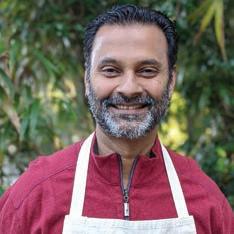
Michael S. Fenster, M.D. (aka Chef Dr. Mike), is a cardiologist, chef and professor of culinary medicine who will present Culinary Medicine: A New Frontier of Fusion to help chefs re-engage, re-forge and reconnect with food. Join “Chef Dr. Mike,” who will take us on a journey that returns us to our roots with a sensible, sustainable approach that is founded on modern evidence-based science.
Join Pastry Chef Tom Vaccaro, CMB , executive pastry chef at Borgata Hotel Casino & Spa in Atlantic City, New
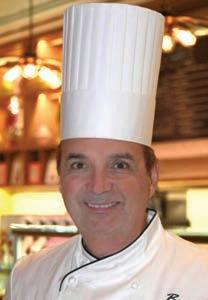
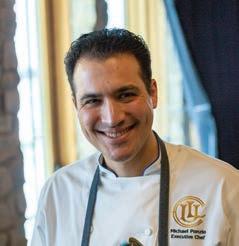
The Virtual Convention: Live and On Demand
Jersey, as he demonstrates his methods and best practices for inspired plated desserts. During Advanced Pastry Techniques: Focus on Plated Desserts, Chef Vaccaro will share caramel and piping techniques, chocolate decorations and modern dessert plating options that you can use to create your next dessert menu.
What is the future of sous vide? During her presentation, The Art & Science of Cooking: The Future of Sous Vide, Chef AJ Schaller, executive chef at the Culinary Research and Education Academy (CREA), will take you on an exploration of cutting-edge techniques, such as extraction and cryoconcentration, and explain how these techniques may help combat food waste.
Join Trichome Institute's Chef Brandon Allen for his session, The Science and Secrets of Culinary Cannabis, as he demonstrates how to prepare cannabis-infused recipes that highlight cannabinoids, terpenes and various infusion methods. Chef Allen will dive into the art and science of cooking with cannabis and explain crucial elements, such as extractions, dosing, THC vs. CBD and myths and tips related to working in the fast-growing culinary cannabis industry.
This is not a complete list — the speaker programming continues to grow. Visit acfchefs.org/events for more info.
We are aware that not everyone is able to travel during these times. If you can’t make it to the in-person convention, it will be live-streamed and available on demand. All mainstage speakers will be streamed live, and there will be an option to chat and network with fellow chefs online. Pre-recorded 10- to 20-minute short demonstrations will be streamed during breaks — available exclusively on the virtual platform. Exclusive virtual content will feature 50 chefs and touch on wide-ranging topics, including Peruvian cuisine, writing a cookbook, mental health and physical wellness, chapter fundraising, successful goalsetting, modern pastry techniques and much more. All content will be accessible for 30 days after the convention. Watch it all live or on demand; you must be registered ahead of time. Visit acfchefs.org to get started.
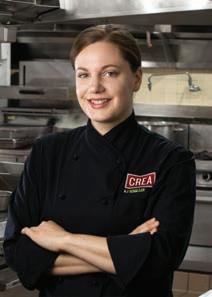
34 NCR | JULY/AUGUST 2021 | 2021 ACF National Convention |
Chef Hari Pulapaka, CEC
Chef Michael Ponzio
Chef Tom Vaccaro, CMB
Chef AJ Schaller
Chef Fred Tiess, CEC, CCA, on Education and ‘Chefpreneurship’
In light of so many chefs and culinarians making career shifts or exploring additional and alternative pathways, Chef Fred Tiess, CEC, CCA, will present a session called Chefpreneurs: 7 Essential Questions For Your Future Business . We caught up with Chef Tiess to learn more about his work as a “chefpreneur” and educator.
How has your work as an instructor at Johnson & Wales University changed this past year?
FT: We introduced a brand new curriculum this past fall. Students are now asking for longer days when they are in person, and then alternating that with shorter days learning on their own. They are looking for more of a mix of academic and lab classes, like we introduced last year out of necessity during the pandemic. There are also many more career pathways for students now. When I was in school, you worked at a restaurant, club or hotel. Now, students can go through a traditional hospitality foodservice program but focus on management or specialize in beverage or even discover ways to start their own ventures by taking food science classes to learn how to develop their own products. It will be exciting to see all the opportunities that come out of this shift in the industry and in culinary education.
Speaking of ventures and “chefpreneurs,” tell us more about your other work through your businesses, Le Guild Culinaire and F&B Resources.
FT: Le Guild Culinaire is a publishing company that produces and distributes “The Chefs Reference Guide” to booksellers and universities around the globe. This recipe-formula matrix helps visual learners and chefs understand and quickly convert the yields of over 1,300 recipes. The text also includes over 3,000 culinary terms in 20 languages, as well as quick references for everything from can sizes to a sous vide chart. F&B Resources is a boutique consulting service I provide for independent ventures. We do everything from secret shopper reports to product development for artisan food startups and have been doing so for over 25 years.
What are you most looking forward to at the convention?
FT: Learning and connecting. It’s been a while since we have had the opportunity to get together and share.
Why have you maintained your membership in ACF over the years?
FT: One of things that I really enjoy is mentoring chefs who are on their certification journey. I certainly know what it is to fail in such an endeavor and how important it is to provide impartial feedback that is based purely on proficiency in skills. It’s one of the reasons I added 150 recipes to “The Chefs Reference Guide” — specifically to help chefs in the ACF certification process.
Chef Fred Tiess, CEC, CCA, is a third-generation entrepreneur and master instructor at the College of Food Innovation & Technology at Johnson & Wales University in Charlotte, North Carolina.

WEARECHEFS .COM 35
Trends: Leveraging Opportunities in the New Normal
It may be too soon for researchers to identify clear food trends for the coming year, but Maeve Webster, president of Menu Matters, will talk about evolving macrotrends in the industry as we emerge from the pandemic, including:
• L abor issues: shortages, training, costs, overall labor reduction
• BOH and FOH technology: balancing the demand for human interaction with thoughtful, solution-based technology implementation
• New frontiers: ghost kitchens, automats, vending
• Sustainability: increased focus and awareness, broadening definition
• Ordering and stock management: disruptors, direct ordering
• C hanging consumer behavior: how shifts in behavior in travel, work and home will impact foodservice
• Diversifying revenue streams: pantries, retail, online, subscriptions
• O ff-premise: impact on packaging, sustainability efforts, security, consistency and satisfaction
Maeve Webster is a leading consultant and thought leader for the food industry. Prior to launching Menu Matters, she was senior director at third-party research firm Datassential.

Santé, Salute, Prost … Cheers!
Join Chef Brian Hay, CEC, CEC, for an interactive presentation, Advanced Wine Pairing For Culinary Professionals, to learn how to train your palate and successfully match food and wine. Whether you are new to the world of wine or already a seasoned professional, Chef Hay, a certified sommelier, will explain how to free yourself from complex, impersonal food and wine pairing rules. He will discuss how exploring preferences and sensitivities can determine the enjoyment of food with wine and how taste components best work together on today's menus. “It’s all
about debunking myths,” he says. “You don’t need a natural gift to understand and experience wine. It’s more about focusing on the scents, because through our nose, we can remember experiences and identify location and flavors. When I take students to Napa Valley, they see me walk through a vineyard and grab soil and smell it. I know that a wine was made from grapes in Rutherford Valley because the wine — and the soil — smells like a baseball diamond to me.” Chef Hay will teach participants how to make other identifications through scents. “As chefs, we are used to smelling different foods and herbs all the time — wine tasting and pairing is no different.”
Chef Brian Hay, CEC, CEC, is the instructional dean for Dallas College’s CPH program and operates his own consulting business, ArtofthePair.com, where he writes numerous articles related to food and beverage pairing.
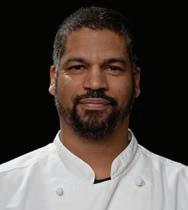
36 NCR | JULY/AUGUST 2021 | 2021 ACF National Convention |
The American Academy of Chefs® 49th Annual Induction Dinner
To be a part of an honor society is truly an honor.
That was the thinking when a group of accomplished chefs, now more than six decades ago, dreamt up the American Academy of Chefs (AAC). Though the academy was officially established in 1955, it was years in the making.
The idea of creating an honor society for the ACF was considered for many years before it was presented officially to officers and members in 1948. It would be another several years and many discussions later before the academy was established during an ACF national convention in Pittsburgh, where delegates voted in favor of the structure and presented bylaws. Chef Peter Berrini, AAC, of Boston, was charged with the responsibility of organizing the academy. He was elected as the first chair of the academy and held that office until 1959, when he was elected ACF national president. At the time, the academy boasted a membership of 37.
“Being an AAC fellow is like the crescendo of your career,” says Chef Americo “Rico” DiFronzo, CEC, CCA, AAC, current chair of the AAC. But it doesn’t stop there. As an AAC fellow (not “member,” Chef DiFronzo points out), you are able to give back in the form of mentorship, scholarships and committees geared toward improving the standards of excellence in the culinary industry.
There are currently more than 800 fellows with the AAC, which is managed by both DiFronzo, executive chef of the Union Oyster House in Boston, and Joe G. Aiello, CEC, AAC, HOF, who serves as AAC vice chair and is executive chef at Apropro Catering, Inc. The AAC is supported by a roster of past chairs, an Honorary Board of Trustees, culinary hall of fame recipients, regional academy directors and various committee chairs. (For the complete list, visit acfchefs.org/ACF/Partnerships/AAC/Board)
“The academy has its own set of policies and procedures and holds its own elections separate from the ACF,” Chef DiFronzo says, “but they were all designed not to conflict with ACF bylaws.” He notes that in order to achieve fellow status, chefs are required to earn two nominations and pass an application review that includes verification of seven mandatory requirements, as well as verification of at least 10 of 22 elective attainable goals, among other stipulations.
This year marks the 49th annual AAC Induction Dinner. It would have been the 50th year if not for the
pandemic, which led to the cancelation of last year’s event. (2020 also marked the 65th anniversary of the AAC). As always, during the dinner, the academy will announce the new fellows, award winners, Hall of Fame and Honorary Hall of Fame chefs and other recognitions, according to Chef DiFronzo. To make up for last year’s cancelation, there also will be more scholarship awards given to upand-coming culinarians.
“The morning before the dinner, there is an academy board meeting where we conduct AAC business, and then the dinner is always one of the highlights of the convention for many fellows,” says Chef DiFronzo, who adds that the black-tie event features a six-course meal.
Chef DiFronzo encourages mid-tier professional chefs, who may be in the midst of earning certifications, to keep records of any and all their accomplishments.
“As chefs, we set goals for ourselves every day,” he says. “Becoming an AAC fellow may seem like a long way off for some, but it’s never too early to set your sights on that high goal.”
For many fellows, the opportunity to give back to the industry is just one of the benefits of being a part of the AAC. “It’s all about giving back and living up to our culinary code,” Chef DiFronzo says. “The reason why the AAC piece comes in after you have earned all the previous certifications is because it really is a major piece of your culinary career, showing that you have come full circle.”
To learn more about the AAC, including the full history written by Chef DiFronzo, visit acfchefs.org/ACF/ Partnerships/AAC. The 49th annual AAC Induction Reception and Dinner will take place Sunday, Aug. 1, at the Orlando World Center Marriott, beginning at 6 p.m. Tickets are available for all ACF Members and are $175 per person, while supplies last. Register at acfchefs.org/ ACF/Events/ Convention.
WEARECHEFS .COM 37
Opposite: Coconut panna cotta with hibiscus eau de vie, ginger meringue and beetroot cake by Chef Danielle Leoni; Above: Jerk shrimp with Southern-style johnnycakes in mango habanero sauce.
FRANK VOLLKOMMER, CMPC
Director of Culinary Industry Development
Auguste Escoffier School of Culinary Arts // By Amelia Levin
working alongside other master chefs and after seeing not only the level of skill but also the level of professionalism from these incredibly talented individuals, I identified earning the CMPC as a professional goal.” Another unintended benefit — aside from showcasing Chef Vollkommer’s excellence in the pastry arts — was helping him improve his teaching ability, which he says has enhanced the student experience.
To that end, earning his CMPC would ultimately seal the deal in education for Chef Vollkommer; he has since stayed in culinary education, having first taught at his alma mater, New England Culinary School in Montpelier, Vermont, for which he also helped develop a new culinary program. It was from there that Chef Vollkommer went to the CIA in Hyde Park, New York, where he taught for nine years. During that time, he also competed in the IKA Culinary Olympics in Germany in 2000, as well as “quite a few” other national and international competitions. “Those experiences ended up serving as good practice for the CMPC exam in terms of helping me push my skills and develop the right competition mindset,” he says.
Chef Frank Vollkommer in 2005 became one of the few chefs to earn a Certified Master Pastry Chef® (CMPC®) designation. Only 11 chefs in the country have this rare certification, the highest offered by ACF for pastry chefs. At the time he earned the certification, the test —like the Certified Master Chef exam — spanned 10 long days and included academic portions in the morning, followed by practical exams in the afternoon. “We were tested on all competencies, from cakes to individual pastries, classic pastries, plated desserts and more,” he recalls. “If you got 75% or better on your score at the seven-day mark, you were invited to the final buffet, which included chocolate petit fours, a sugar showpiece and a competition-style dessert platter for six to eight people. I made it through the first run, but had to redo the buffet and after practicing and refining my items, went back a year later and passed.”
With so much time, effort, practice and even retesting involved, why even go for it? “I have always wanted to be the best that I could be at my craft,” Chef Vollkommer says. “When I was teaching at the CIA [Culinary Institute of America], I was
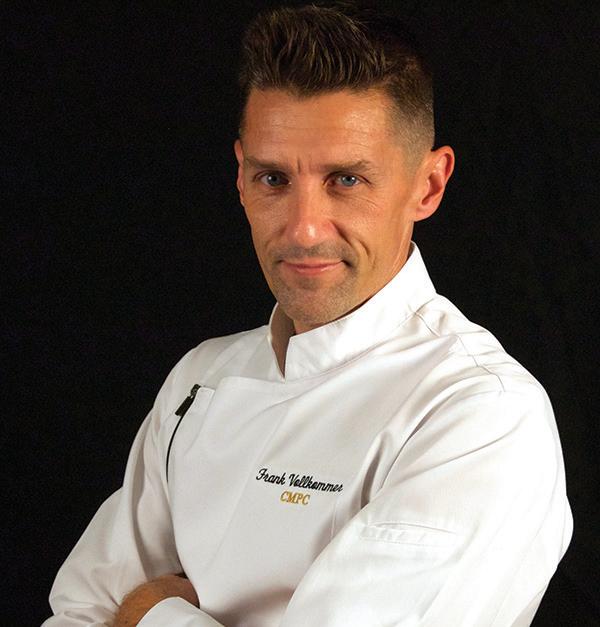
Chef Vollkommer ultimately shifted gears at one point — doing some consulting work for a chocolate manufacturing company and helping open a country club in his hometown of Saratoga Springs, New York. In 2008, he opened and ran his own pastry shop and café along the Hudson River in upstate New York called The Chocolate Mill, which he calls his “dream business.” For six years, Chef Vollkommer had a successful run as an entrepreneur, opening three locations that served up a variety of pastries, chocolates and baked goods, each with an on-site café.
In the end, though, he returned to teaching — selling his business in 2014 and taking a job as a chef-instructor for the baking and pastry degree program at Johnson & Wales University in Providence, Rhode Island. During that time, he wrote the curriculum for two new degrees: Associate of Science in Baking and Pastry and Bachelor of Science in Baking and Pastry Arts.
Chef Vollkommer has no regrets about the switch back to education. “I needed to do the entrepreneurial thing for myself, and I’m so glad I did it because I learned quite a lot about business, economics and everything that goes into running a business while improving my craft at the same time,” he says.
A plus side of the J&W post was being able to be a student again; during his tenure there, Chef Vollkommer earned a
38 NCR | JULY/AUGUST 2021 | ACF Chef Profile |
master's degree in education. The experience was so positive that he now says he “realized education was my career. In the past, when I would meet someone and they would ask me what I did, I would have said that I’m a chef and also an instructor.” Today, however, Chef Vollkommer says his answer is, “I’m an educator, and I happen to be a chef.”
All of these experiences would ultimately culminate in his current job as director of culinary industry development with Auguste Escoffier School of Culinary Arts, where he landed in January. The position combines each of Chef Vollkommer's pursuits: master pastry chef, educator, curriculum developer, business professional and consultant.
“What’s cool about the position is that my role and responsibilities straddle all of the different department initiatives. I have the pleasure of working with academic departments in the development of new curriculum, and I also work with industry partners as part of the consulting arm of the school to help hotels, chains and other foodservice providers develop end-to-end training and educational programs,” says Chef Vollkommer, who draws upon his skills as a CMPC to help these businesses develop certification programs. He also regularly works with the school’s
marketing department to develop industry-facing educational content and even fun videos for social media. “I look at it like juggling a few different jobs at once.”
Auguste Escoffier had an advantage during the pandemic because of its all-remote platform, which was in place before COVID-19. “The pandemic provided an opportunity to even further refine virtual instruction,” Chef Vollkommer says. Leveraging modern technology, the school offers live video sessions, as well as one-on-one time with instructors for questions and feedback. Students also review instruction videos online and are assessed on their delivery through extensive photo and video documentation and detailed wrap-ups indicating they have — no pun intended — fully digested the material. Many students also go through a “work and learn” program to get hands-on industry experience while earning their degree.

When not hard at work or posting beautiful pastry arts photos on his Instagram account, Chef Vollkommer enjoys pursuing his other, much faster hobby: motorcycles.
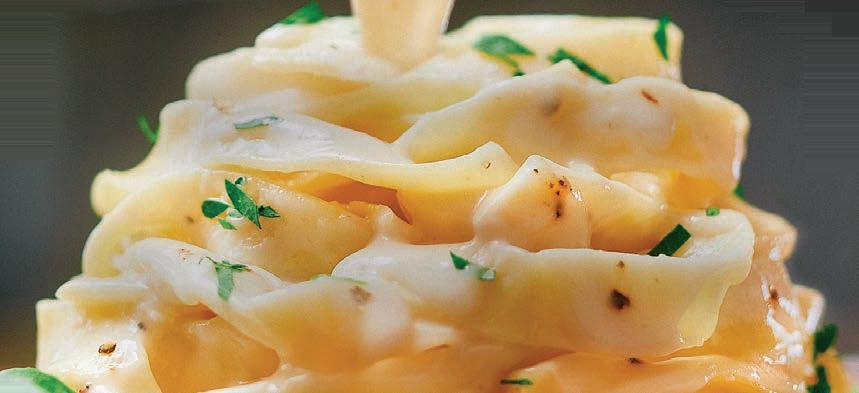
Oh, and everyone else. MAKE IT INCLUSIVE. MAKE IT IRRESISTIBLE. Get a FREE sample at MINORSFOODSERVICE.COM VEGAN ALFREDO All trademarks are owned by Société des Produits Nestlé S.A., Vevey, Switzerland. Open to Foodservice Operators in the 50 US & DC, 18+ (19+ in AL/NE). While supplies last or 12/31/21. Subject to Terms: minorsfoodservice.com.
Appeal to vegans.
ADVERTISEMENT
YES IS THE ANSWER
What a Chocolate Milkshake Taught Me About Building a Great Company Culture
By Cameron Mitchell
All effective leaders understand that a strong company culture is key to a successful business. But it’s one thing to identify the kind of culture you want; it’s another thing to ensure your people fully embrace that culture and live it out every day through their behaviors and interactions with colleagues and customers.
This is a challenge I have faced time and again in my 25 years of owning restaurants around the country. I had worked tirelessly to drive home our culture of hospitality — that yes is always the answer when it comes to how we treat both customers and our people. But years ago, I realized our people hadn’t fully embraced that philosophy. And a chocolate milkshake emerged as the symbol of how I wanted to build and maintain the culture of my company.

One rainy Saturday afternoon in 2002, my family and I went out to a local restaurant for a late lunch. Not long after we settled down at our table, a server appeared and began to take our orders.
“I’d like a grilled cheese and chocolate milkshake for my son,” I said.
This seemed simple enough, but I really stumped her.
“I’m sorry, sir, we can’t do that. All we have is a large Häagen-Dazs milkshake on the menu, and it would be way too much for a young child.”
“I understand. But would you please ask your manager?”
I watched our server walk over to her manager and explain. From across the room, I could see the manager shake her head while her lips formed the word no. The server returned to the table.
“Sorry, sir. We just can’t do it.”
“Would you please send your manager over to our table?”
The manager arrived. She reiterated that they couldn’t make a small milkshake because they preportioned the ice cream, and if they used less than one serving, it would throw off their inventory. I had spent my life in restaurants and knew they didn’t preportion ice cream, but I forged on with a smile.
40 NCR | JULY/AUGUST 2021 | Chef-to-Chef |
“Well, how about a chocolate milk instead?” I asked. She was visibly relieved. “Of course, I can get you a chocolate milk.”
She thought she was delivering hospitality at that point and turned away to get the chocolate milk.
“Excuse me,” I said. “Before you go, I have a question….” I pointed to two items on the menu, a warm carrot cake and a hot brownie with the option of à la mode for $2.95.
“What does à la mode mean?” I asked.
By now, my wife was looking away, trying not to associate herself with the persistent guy sitting at her table.
“Oh,” the manager replied, “that is a scoop of ice cream added to the dessert.”
I said, “Really? Oh, cool. Can I have an order of à la mode to go with my chocolate milk? And would you mind whipping it all up in a blender?”
“Okay, sir,” she said with an admonishing tone. “But that will be expensive.”
“I’m a big boy,” I said. “I can handle it.”
She left the table, and my wife fumed. “I told you they don’t take care of kids here. I can’t believe their attitude. We’re never coming here again.”
We had the rest of the meal, and it was fine.
A couple weeks later, I was the keynote speaker for our local business magazine. There I was, onstage, proud as a peacock in front of 500 people, sharing the milkshake story and proclaiming that such a thing would never have happened at a Cameron Mitchell restaurant, where we provide genuine hospitality.
A week later, a woman came up to me and said, “My husband heard you speak at the Hyatt, and he thought you were great.”
I smiled and thanked her.
“He especially loved the milkshake story. But you know, afterwards, he went into one of your Fish Market restaurants and ordered a milkshake. The bartender said no, he was sorry, but they didn’t make chocolate milkshakes.”
I couldn’t believe what I’d just heard. She might as well have punched me in the gut.
The next Monday morning, reeling from the experience, I recounted the story and asked our executive team, “What do we need to do to reinforce for our people what we’ve been teaching all these years: ‘The answer is yes. What is the question?’ What do we need to do to drive it home? Clearly, we have not made the impact we’d hoped.”
That day, we brainstormed and decided that a chocolate milkshake would become the symbol of our culture. We would use the milkshake story and the beverage itself again and again to emphasize that the answer is always yes and that we are great people delivering genuine hospitality.
Today, each person who starts working at Cameron Mitchell Restaurants receives a chocolate milkshake and goes through a four-hour orientation to our culture and values. Milkshakes appear at regional meetings, special events and other important moments. Managers celebrate associates who win our weekly Milkshake Award, for going above and beyond the call of duty, with a milkshake toast. We even created a company icon with a picture of “Flo the Waitress,” who shares a beaming smile and extends a tray with a chocolate milkshake on it. Today, we make thousands of milkshakes a year and celebrate our important events with this symbolic drink and toast — sometimes in humorous and surprising ways — to reinforce to our people: “The answer is yes. What is the question?” It is natural to us that when a guest asks us for something, we say yes. We go out of our way to care.
Our yes attitude extends far beyond guest service. When an associate requests time off to care for family, or when a local charity asks for a donation, or when a purveyor or other company we do business with seeks a favor, the answer is yes. Yes is not a tactic we use to manipulate people into working harder in a scheme of greater profit. Yes is the answer because it is who we are, and it’s the right thing to do. Our success is a byproduct of this simple philosophy that has become the foundation of our company culture — and our success.
Here are some tips for driving home your culture throughout the company: Overcommunicate your culture and values, 24/7. Never assume you have communicated enough. Measure the impact of your culture and values on the company and its people all the time. What gets measured gets done. Live the culture and values every day. The moment you don’t, their impact immediately begins to diminish.
Cameron Mitchell is the author of “Yes Is the Answer! What Is the Question?: How Faith in People and a Culture of Hospitality Built a Modern American Restaurant Company.” He is the founder and CEO of Cameron Mitchell Restaurants, which has been in business for 28 years, and at one point, had 60 restaurants from coast to coast and employed almost 5,000 people. Chef Mitchell attended the Culinary Institute of America and became an executive chef by age 23, a restaurant general manager by 24 and president of a restaurant company (55 Restaurant Group) by the age of 35. In 2008, Chef Mitchell sold two of his most popular concepts — Mitchell’s Fish Market and Mitchell’s Steakhouse — to Ruth’s Hospitality Group for $92 million. Watch Chef Mitchell in action at the 2021 ACF National Convention, for which he is a keynote speaker.
WEARECHEFS .COM 41
CORN AT ITS CORE
This starchy vegetable has more health properties and history than one might think //
By Chef Jennifer Hill Booker
Whether you call it “soul food” or simply “Southern cuisine,” finding just one dish to represent all of the American South is almost impossible.
Southern cuisine is a glorious mix of Native American, West African and European ingredients, cooking methods and points of view. With our rich and diverse food heritage, Southerners already find it hard to agree on what to call our food. But, if pressed to pick one ingredient to represent all regions of the South, I think corn would be a strong contender.
First of all, it’s jam-packed with several health benefits. Yes, corn is considered a starchy vegetable. But instead of viewing it as unhealthy, let’s take a closer look at which vitamins and minerals one serving of corn can provide the human body. Corn contains valuable B vitamins, which are important to our overall health. Corn also provides us with essential minerals such as zinc, magnesium, copper, iron and manganese — all in this one vegetable. It may surprise you to know that eating corn could also help promote eye health since corn is a good source of lutein and zeaxanthin, two carotenoids and antioxidants. And with its high fiber content, corn will also aid in digestion.
Now that we know corn is such a powerhouse of nutrients, you may ask, "Why is corn such a popular ingredient in Southern dishes?" Some would say it’s because corn has been around for a long time; it was one of the first crops Native Americans shared with colonizers. Others might say it’s because corn was
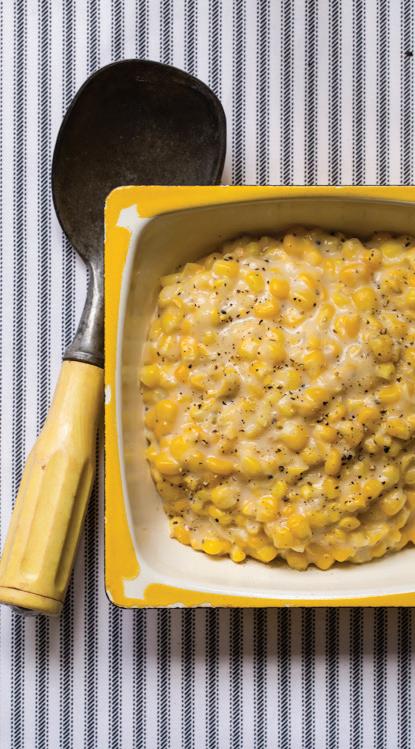
42 NCR | JULY/AUGUST 2021 | Health |
Southern fried corn by Chef Jennifer Hill Booker.
so frequently used by enslaved people when cooking their owners’ meals that the ingredient then influenced the owners’ preferences and palates. It could also be that corn is easily preserved in many different forms, which made it a survival food for Native Americans and early Southerners. Perhaps it is corn’s low cost and high nutritional content (when whole and unprocessed) that makes it so popular. All of these sound plausible to me, and I’d add versatility to the list of reasons why corn has become such a mainstay of Southern cuisine.
Many Southern ingredients are only used for meals at specific times of the day. For example, collard, mustard or turnip greens are all very popular “down South,” but you would rarely see them served at breakfast — brunch, maybe , but not breakfast. Pork is a favorite meat of Southerners, but while it’s common to see pork chops, sausage and bacon on the breakfast table (and sometimes for lunch), you’ll rarely find pork served during dinner. That’s what makes corn so great. It isn’t limited to when it’s served. It can be a nice addition to any meal: breakfast, lunch, dinner and even dessert.
Here’s my rundown of some popular corn-based dishes that are synonymous with Southern cuisine: cornbread, grits, hoe cakes, spoon bread, hush puppies, hominy, corn pudding and — of course — cornmeal-crusted fried okra or fish. This list is by no means all of the Southern dishes you’ll find showcasing corn.
There’s also my very favorite: fried corn. And to be clear, I’m not talking about deep-fried corn on the cob. This dish consists of corn kernels and ‘corn milk’ that are removed from fresh corn cobs and then cooked in a cast-iron skillet with rendered salt pork, a bit of flour and lots of black pepper and salt. When I took a minute to think about why such a timeconsuming dish could be so popular, the answer went back to preservation. Like boiled corn on the cob, fried corn was a way to enjoy the fresh ingredient before the majority of the crop was dried to later become hominy, grits or cornmeal.
I stand behind corn as my choice of the best ingredient to represent the South. It’s versatile and rich in history, flavor and nutrition.
Southern-born Chef Jennifer Hill Booker studied French cooking at Le Cordon Bleu College of Culinary Arts in Paris and is the author of “Field Peas to Foie Gras: Southern Recipes with a French Accent” and “Dinner Déjà Vu: Southern Tonight, French Tomorrow.” She recently launched Your Resident Gourmet Cooks!, a line of spice blends, seasoning salts and flavored sugars.
Southern Fried Corn
(From “Field Peas to Foie Gras: Southern Recipes with a French Accent” © 2014 Jennifer Hill Booker, used by permission of the publisher, Pelican Publishing Company, Inc.)
This Southern favorite showcases fresh, sweet corn off the cob. Using a cast-iron skillet is a must when making this dish because it adds a depth of flavor stainless steel just can’t match.
Yield: 6 servings
Ingredients:
• 6 ears fresh corn, shucked
• 2 T bsp. rendered salt pork or bacon fat
• 2 T bsp. unsalted butter
• 2 T bsp. all-purpose flour
• Salt and fresh ground black pepper, to taste
Method:
1. Using a sharp butcher knife, slice the corn kernels from the cob.
2. Using the back of the knife, scrape the corn cob downward to get the ‘corn milk’ and any remaining corn kernels left on the cob.
3. Heat a heavy cast-iron skillet over medium-high heat and add the bacon fat and butter.
4. Once the butter has melted and the bacon fat is hot, stir in the corn, corn milk and flour.
5. Cook for 20-25 minutes or until the corn kernels are tender, stirring often.
6. Season with salt and pepper.
7. Serve piping hot.
WEARECHEFS .COM 43
Education Transition
A look at how educators transitioned to online learning in the past year, and what the future holds for students // L iz Barrett
Foster
Here’s a riddle: When does a beautiful, chewy loaf of artisan bread become a rock-hard lump of flour and yeast? Answer: when there’s no culinary instructor around. When schools across the country pulled the plug on inperson instruction last year due to COVID-19, instructors everywhere — including those inside culinary classrooms — scrambled to create a seamless transition to online learning. However, the big difference between, say, learning English and learning how to cook is that culinary instruction depends on hands-on instruction. With no teacher nearby to stop a student from adding too much or too little of an ingredient, to remind students to turn down the heat or to help practice safe knife skills, the results can be unappetizing or downright dangerous.
Forging a New Format
Students were already on spring break from Joliet Junior College in Joliet, Illinois, when COVID-19 hit in 2020, according to professor and Pastry Chef Andy Chlebana. “The school extended spring break by a week and then another week, and then we finished out the spring semester online,” he says. “It was challenging, and it was hard to tell students that they had to go buy groceries [for testing at home] when at times you couldn’t even find flour or yeast in the stores.” Classes resumed last August at half capacity.
Under normal conditions, Guided Discoveries and Camp CHOP run two locations on the East and West coasts that are open to campers, as well as high school and college students. Chef Samuel Spencer, foodservice director and culinary arts

44 NCR | JULY/AUGUST 2021 | Segment Spotlight |
Chef Samuel Spencer, foodservice director and culinary arts instructor for Guided Discoveries and Camp CHOP.
instructor for Guided Discoveries and Camp CHOP, says that while a portion of classes have always been available online to students, the entire program transitioned online for a year during the COVID-19 pandemic. “As culinary arts students, the highlight of their day would be coming to that lab for hands-on instruction,” Chef Spencer says. “But during COVID, students had to log into Zoom and follow instructors who tried to keep everything interesting and engaging.”
Chef Mary Levinski is a culinary instructor and ProStart coach at Sauk Rapids-Rice High School in Sauk Rapids, Minnesota. Her students earn college credit and are ServSafe certified upon completing their coursework. “Last fall we came back as a hybrid model, with half the kids in school on Monday, Tuesday and the other half attending on Thursday, Friday,” Chef Levinski says. “Then we went totally distant, and now we're all back in person.”
With students attempting to learn while completely outside of the classroom, and then with hybrid in-class learning, Chef Levinski says instructors and students had to rethink food preparation entirely. “We had to look at safety precautions, beginning from how we ordered our food and how we received it,” she says. “That entire flow of food — making sure that we wore masks, stressing the gloves, prepping food, individually wrapping it or packaging it in disposables — all changed.”
The new format wasn’t without its setbacks. Chef Levinski recalls sending recipe kits home with students only to find that some didn’t read the full recipe. “In one assignment, students were supposed to make a pumpkin cake roll, but a few students made pumpkin bars instead,” she says. “We addressed some of those things when we were back in the classroom, but we couldn’t go backward. We needed to keep moving forward.”
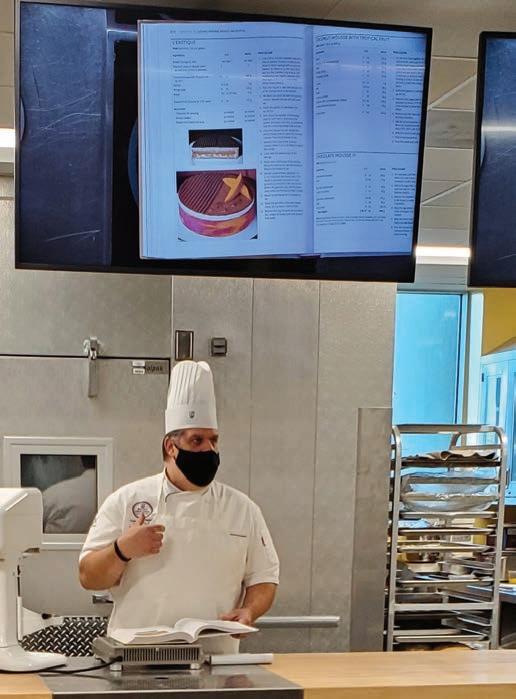
Student Concerns
Not surprisingly, some students did question how online instruction and hybrid classrooms might affect graduation or their success in future courses. Joliet Junior College offered students the option to withdraw from their current class and retake it at no additional cost the following semester, according to Chef Chlebana. “We had some students take advantage of that offer, but very few,” he says.
WEARECHEFS .COM 45
“I THINK WE LOST A LOT OF BUSINESSES DURING COVID, BUT ON THE FOODSERVICE AND HOSPITALITY SIDE OF THINGS, IT’S GOING TO BE BIGGER AND STRONGER [IN THE FUTURE].”
-CHEF ANDY CHLEBANA
Pastry Chef Andy Chlebana teaches a course with enhanced sanitary protocol.
Students at the high school level approached Chef Spencer with concerns about the state of the industry due to circumstances caused by the pandemic. “They wanted to know if certain jobs would still be there when they graduated,” he says. “I think we lost a lot of businesses during COVID, but on the foodservice and hospitality side of things, it’s going to be bigger and stronger [in the future].”
Endless Opportunities
While many restaurants have had to let go of bussers, servers and hosts over the past year due to dining room closures, Chef Spencer says that to-go orders and catering have picked up, translating to an uptick in the need for back-of-house staff, and chefs in general. “In tourist towns especially, they’re ready to open back up and start making money,” he says. “Hotels and convention centers are already calling and asking me if I have any culinary students I can send their way.”
Chef Levinski says, “Every high school kid thinks they’re going to graduate from high school, go to college and become a millionaire the day after they graduate. But they have to work their way up.”

Luckily, there’s always a demand for foodservice staff, and many times, those opportunities are in places that new graduates don’t consider. Outside of restaurants, Chef Levinski says, there are numerous culinary opportunities available within retirement communities; hotels; restaurant management; executive chef positions with food brands; the medical field; catering; high school and college campuses; and personal chef roles.
“We see a lot of students starting smaller home-based businesses,” Chef Chlebana says. “People want to buy from the little guy now.” At the same time, Chef Chlebana continues to receive a steady influx of calls asking him for cooks. “The tough part is that some people are still on unemployment or happy with what they have left from their stimulus check,” he says. “I don’t know why people don’t want to go back to work right now. The jobs are out there and starting to pay more. I’ve been trying to explain to students that they have a golden opportunity right now to get in somewhere that they may not have been able to get into before.”
The brief transition to online learning also opened a new path to learning for some. At Joliet Junior College, Chef Chlebana says courses such as portioning and supervision will go back to being held in person, but the school has decided to keep its sanitation class online. “We haven’t noticed a difference in the pass/fail sanitation certification exams between in-person and online, so we’ll continue to run that online,” he says. “Plus, I plan to keep some of the online components I created. You get to give the students a way to engage when they’re not in the classroom.”
46 NCR | JULY/AUGUST 2021 | Segment Spotlight |
Chef Mary Levinski with some of her culinary students at Sauk Rapids-Rice High School in Sauk Rapids, Minnesota.
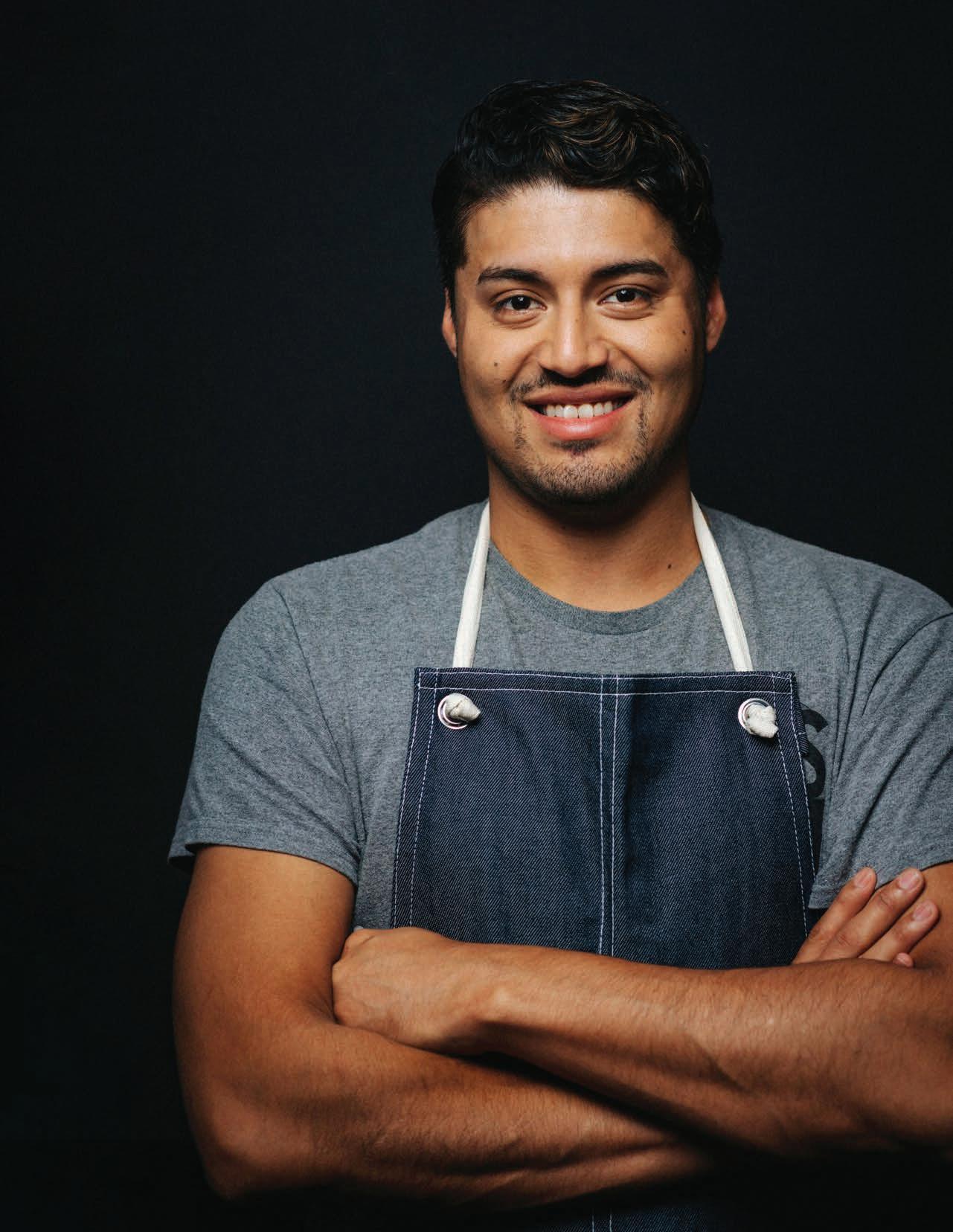
2021 ACF Event Sponsors








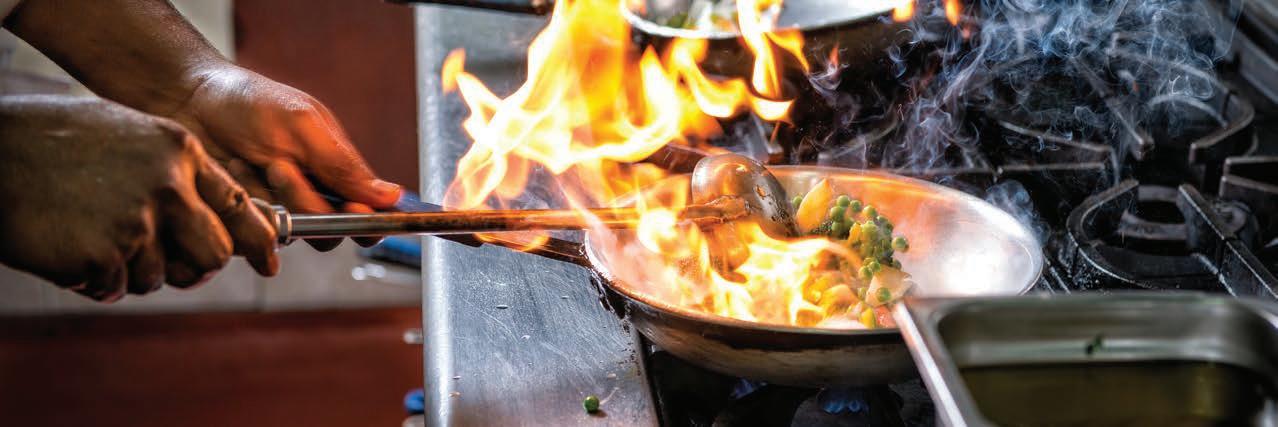
Welbilt

ACF National Convention Orlando World Center Marriott August 2-5, 2021 To join us In-person or Virtually , register at ACFChefs.org/Events today.

50 NCR | JULY/AUGUST 2021 | At The Bar |
Non-alcoholic gin and tonic at Bitter & Twisted in Phoenix.
DON'T CALL THEM MOCKTAILS
After a less-than-sobering year, younger consumers are swapping heavy drinks for low- and no-alcohol cocktails that still pack plenty of flavor // Lauren
Kramer
There are restaurateurs and bar owners who might scoff at the words ‘mocktail’ or ‘virgin cocktail,’ but the statistics on alcohol-free beverages are sobering. Over the past four years, this category has grown by 383%, according to third-party research firm Datassential. Despite this incredible climb in demand, sophisticated alcohol-free beverages appear on only 1% of menus in the United States. If there was ever an untapped opportunity, this is it.
Mark Brandau, group manager at Datassential, notes that Generation Z consumers are more likely to know about and ask for non-alcoholic beverages than are older demographics. “The young generation is definitely more sober-curious, and for this age group, notions of health mean abstaining from alcohol more often than older consumers,” he says. Gen Z and younger millennial consumers are more likely to participate in “SoberTober” in October or “Dry January” in the new year, he adds, and they are more likely to prefer alcohol-free drinks to lowalcohol beverages.
In a January 2021 Datassential consumer survey, two-thirds of consumers surveyed were not interested in drinks with low alcohol by volume. “They showed more interest in things like a mocktail, a virgin drink, a high-end punch or a crafted drink that isn’t meant to mimic alcohol,” Brandau says. “We found one in five people have never been drinkers of alcohol. That’s in addition to the 10% that have stopped drinking, so we’re getting close to one in three people that are not in the market for any alcohol. Based on this research, it’s well worth it for restaurateurs to explore high-end beverages that are alcoholfree but still belong in fancy glasses and can still carry a decent price point.”
Non-alcoholic drinks on menus today most often carry the flavor pairings of cranberry, strawberry and pineapple. “There’s a really healthy demand for virgin frozen drinks like daiquiris and tropical blended drinks,” Brandau says. “Kombucha is another beverage that’s growing on its own and makes a good base for high-end drinks. And ginger beer gives mixologists lots of opportunity to experiment with mocktail mules.”
Kim Haasarud, a Phoenix-based mixologist and consultant with Liquid Architecture, is unsurprised by the statistics. “Even before the pandemic, the move toward alcohol-free beverages was strong, but the new generation is really interested in experiences that don't necessarily involve alcohol,” she says. Many companies are coming out with new non-alcoholic spirits, as well as distillates heavily infused with botanicals, herbs and spices, Haasarud notes. In addition, bar owners and pop-up companies are creating their own non-alcoholic spirits and mixers in an effort to offer their diners alternatives. “The opportunities for creativity are numerous in this category,” Haasarud says. “There’s no need to abide by licensing requirements and there is so much flexibility with low-calorie and alternate sweeteners. It’s a whole new world to explore.”
At Haasarud’s newly opened Garden Bar PHX in Phoenix, 30% of beverages on the garden-to-glass menu are nonalcoholic. “It’s about giving consumers more drinking options,” she says.
“There are a lot of people who don’t drink — recovering alcoholics, pregnant women, designated drivers — and they have expendable income but previously their only beverage options were coffee, tea and soda,” Haasarud says. “Even people who do drink alcohol don’t necessarily want to drink it the
WEARECHEFS .COM 51
entire time they’re out. So it’s a great idea to offer well-crafted, alcohol-free beverages on your menu because the demand is out there. People want more non-alcoholic beverages, and they’re willing to pay for them.”
Where to begin crafting your mocktail? Approach it the same way you might a cocktail. “Start with your main ingredient first and create a list of what flavors go well with it,” Haasarud says. “Celebrate the flavors and use juices, fruits and infusions.”
Ross Simon, owner of Bitter & Twisted in Phoenix, began offering alcohol-free cocktails when he opened seven years ago. His Lime & Thyme soda is a cordial that uses citric acid and malic acid for acidity, sudachi juice from Japan and a topping of carbonated club soda. “It’s a nice, bright flavored non-alcoholic beverage that’s delicious, approachable and complex without being overwhelming,” he says. Menued for $5, it is served in a wine glass with a couple of grapefruit slices.

52 NCR | JULY/AUGUST 2021 | At The Bar |
"PEOPLE WANT MORE NONALCOHOLIC BEVERAGES, AND THEY'RE WILLING TO PAY FOR THEM."
KIM HAASARUD MIXOLOGIST, LIQUID ARCHITECTURE
Spirit-free watermelon blueberry lemonade (Credit: National Watermelon Promotion Board).
Another popular beverage on his menu, Miss Nightingale, uses hibiscus infusion, fresh lime juice, beet syrup, grapefruit cinnamon syrup and sage leaves, all carbonated together. “It’s served in a nice goblet, looks very effervescent and you’d never know it was alcoholfree if you were sitting beside someone drinking it,” he says. Simon and his team make their syrups in-house and have five varieties of alcohol-free cocktails on the menu.

Each of Barter & Shake Creative Hospitality’s three cocktail concepts at Century Grand in Phoenix (Platform 18, Grey Hen Rx and UnderTow) offer non-alcoholic options. The No. 1 seller at Platform 18 contains Seedlip Grove 42 citrus, Giffard non-alcoholic bitter aperitivo, devil bean, guava-leaf-infused acacia honey, acidified strawberry juice and lime. Another popular beverage contains house-made experimental “gin” made with botanicals, along with house-made rhubarb amaro, peach, acacia honey, pineapple juice, lemon and lime juice.
The non-alcoholic cocktails menu for $10-$12, and while they only represent 0.5%-0.8% of total beverage sales, their presence is important. “We promote these drinks and make them more visible because we all agree that when there are guests in a group attending a social gathering and they don’t drink alcohol, they tend to feel left out,” says Kailee Asher, communications director for Barter & Shake. “We wanted to offer them the same quality of guest experience as we do to those who do drink alcohol — without compromising flavors.”
Herein lies the conundrum for many diners: the pressure to fit in when socializing in a group where the alcohol is flowing freely. Abstain from alcohol in this context and you attract unwanted attention for your soda or glass of water. But order a well-crafted alcohol-free drink that arrives in a beautiful piece of glassware and is a treat to the tastebuds, and no one asks questions.
“This is important from a customer experience perspective,” Asher says. “We understand that our alcohol-free selection isn’t going to keep the lights on when it comes to profit. But we choose to create elevated alcohol-free cocktails that have a similar profit margin to our actual cocktails, and that gives guests the same quality and experience as those who are drinking alcohol. Oftentimes, they can even be ordered without the other guests in the group realizing that you aren’t drinking alcohol at all. So it’s the perfect opportunity to enjoy the company of others without feeling guilt or getting a buzz.”
No buzzkill needed.
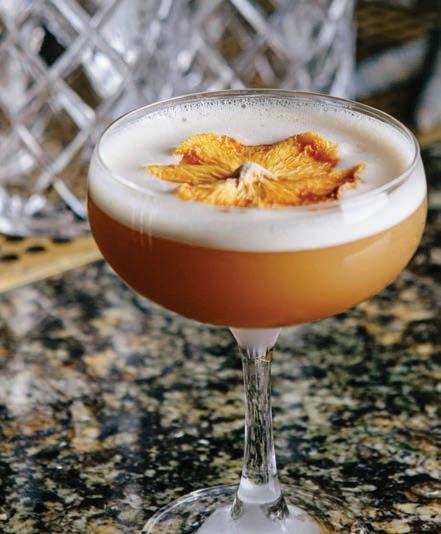
WEARECHEFS .COM 53
Top: The Baltimore MD with Seedlip Garden 108, grapefruit syrup, lime juice and bitters at Century Grand in Phoenix. Bottom: The Conjuration with two types of bitters, lime juice, pineapple syrup and dehydrated pineapple from Grey Hen Rx in Phoenix.
Lauren Kramer is an award-winning writer based in the Pacific Northwest. She has been a regular contributor to the National Culinary Review for the past 16 years.
NCR Quiz
July/August 2021
By LeeAnn Corrao, CFC®
Sophisticated, alcohol-free beverages appear on only of menus in the U.S.
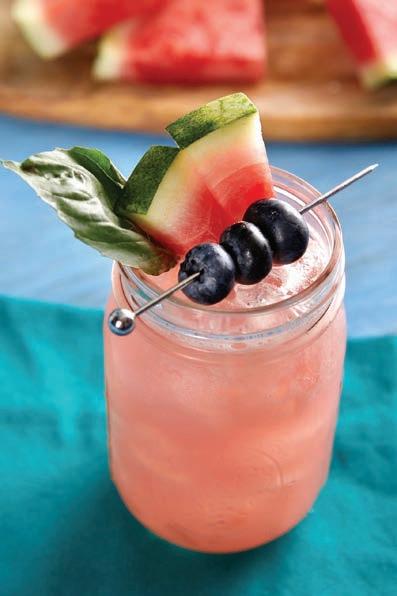
a. 1%
b. 2%
c. 5%
d 8 %
What demographic of consumers are more likely to prefer alcohol-free drinks to low-alcohol beverages?
a. Generation Z
b. Millennials
c. Generation X
d. Baby Boomers
Which of the following is a mentoring and training program for up-and coming looking to get their footing in the culinary industry?
a. Culinary Research and Education Academy
b. Culinary Coach, LLC
c. Guided Discoveries
d. Camp CHOP
What percentage of head cooks in the United States are women?
a. 12 %
b. 22%
c. 35 %
d 41 %
What is one way Chef Occhipinti takes a personalized approach to leadership?
a. Meets for lunch/coffee one-on-one
b. L earns everyone’s name
c. Gives honest feedback
d. A ll of the above
How many ACF national conventions has the ACF Central Florida chapter hosted?
a. 5
b. 8
c. 10
d 12
What percentage of food trucks permanently closed due to the coronavirus pandemic?
a. 12 %
b. 18.5 %
c. 22.5 %
d . 31 %
Consumers today expect food trucks to be
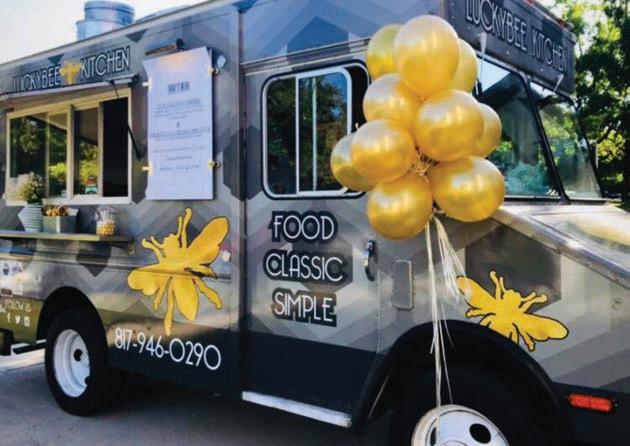
a. Fa st
b. Only available in large cities
c. Barbecue or concession-style food
d. A ssociated with a restaurant
What does Chef Novick recommend before opening a food truck?
a. Purchase a generator
b. Contact local fire marshal and health departments
c. Decide on a theme
FlagShip Culinary Services has offered which of the following flavors?
a. Pistachio
b. Dur ian
c. Saffron
d. A ll of the above
Which corn-based food is not synonymous with Southern cuisine?
a. Corn bread
b. Corn tortillas
c. Gr its
d. Hush puppies
See the rest of the questions, finish the quiz and earn 4 CEHs toward your certification on ACF’s new Online Learning Center at acfchefs.org/olc
54 NCR | JULY/AUGUST 2021 | Quiz |
Jones Farm is a 7th owned and comp and time-honored traditions to create distinctive and timeles



Jones Dairy Farm is a 7th generation family owned and operated company that for more than 130 years, has been using real, natural ingredients, original recipes and time-honored traditions to create distinctive and timeless products. A better breakfast starts with All-Natural* Sausage from a brand you can rely on and trust. Jones All-Natural Chicken Sausage is made with fresh cuts of meat, our authentic blend of spices and no fillers, binders or artificial ingredients added. Jones All-Natural Chicken Sausage delivers tons of bold flavor while leaving out what customers don't want.
Please visit us at booth 707 at the F ational onvention in Orlando.
For a sample of our All Natural Breakfast Sausage, Dry Aged Bacon, Naturally Smoked Ham, or Organic Veggie Burgers contact: Jim Glynn - jimg@jonesdairyfarm.com

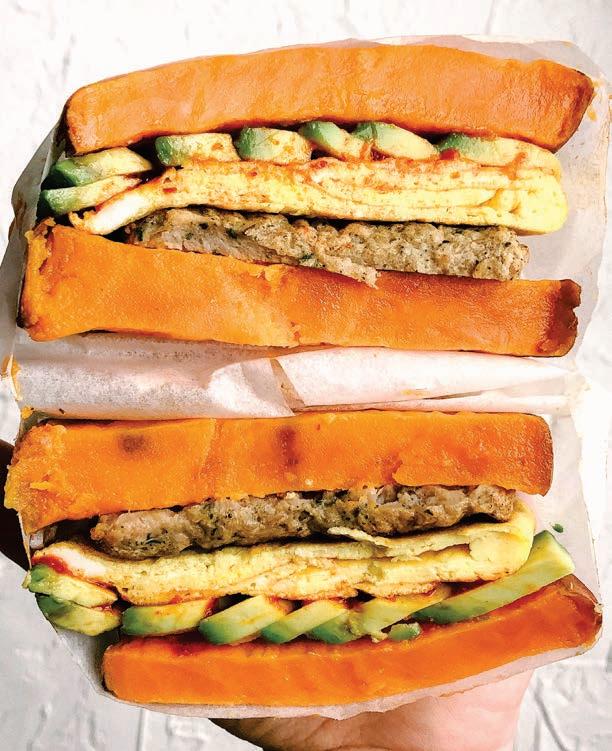
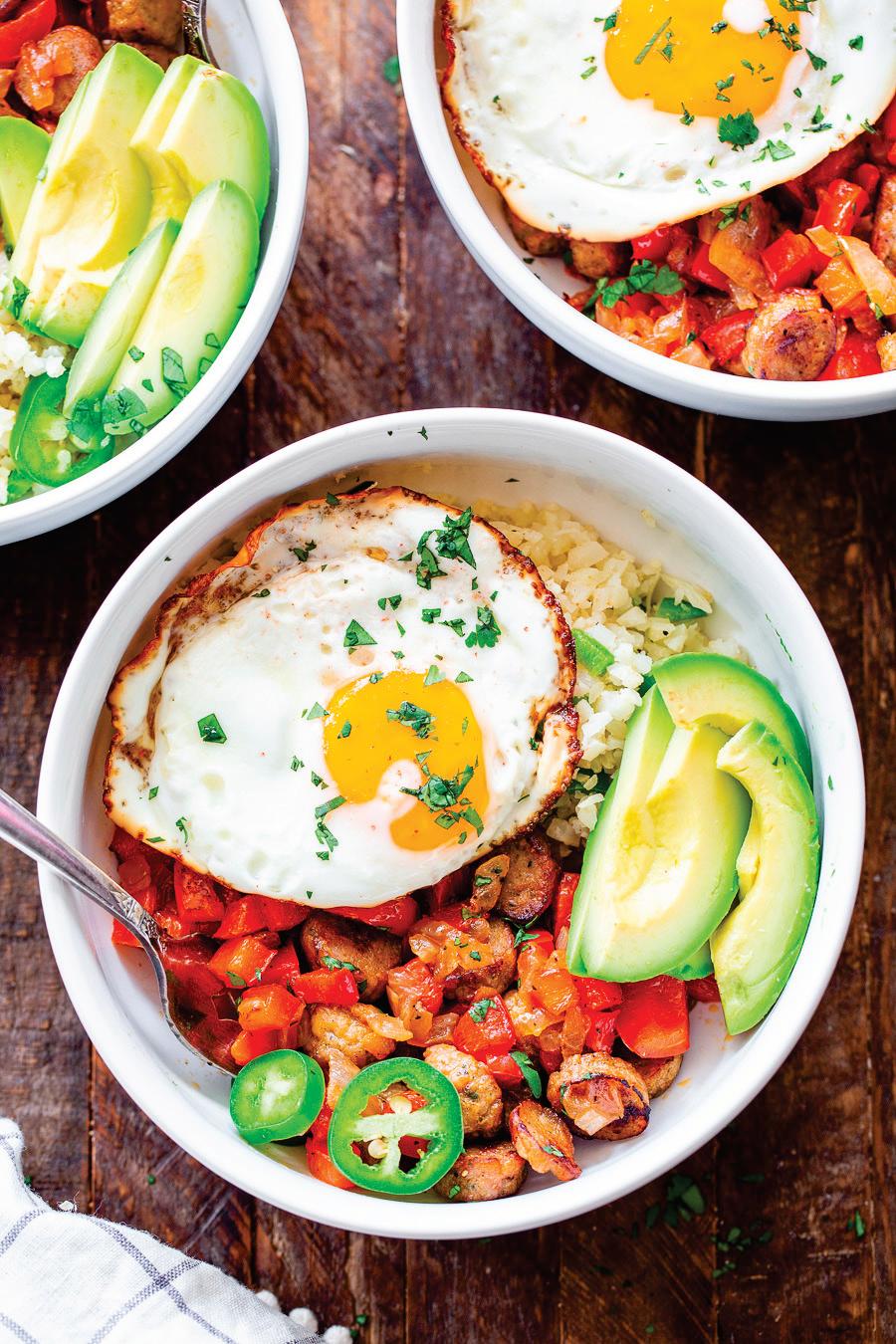


-* -
JO *

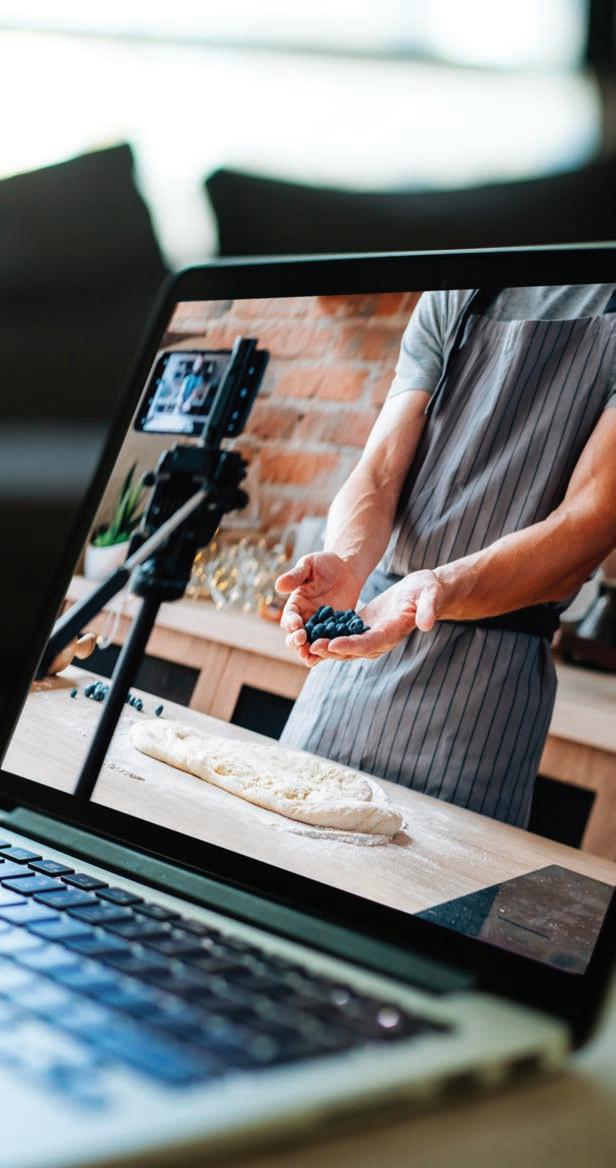
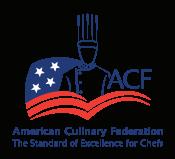
NEW YEAR. NEW SKILLS. Take time this new year to elevate your culinary knowledge and skills. Join our ACF Chefs Forum Webinar Series to learn from your peers and grow your career. Find out more at WeAreChefs.com ChefsForum W EBINAR SERIES





















































































































